Intro
Three parts to a journey: preparation, execution, and reflection. I’m finding that I learn even more about a place after returning from it.
I’d visited New Mexico three times in pre-Linda travels with my previous family, the one that produced kids: 1978, 1988, and 1989. L spent some time in the Land of Enchantment during her childhood and when moving from Utah to Texas in 1990. This was our second time in that state together.
Saturday, July 10, 2021
Day before, we laid our our gear on the LR floor in the same footprint as the vehicle’s. Reality came rewardingly close.
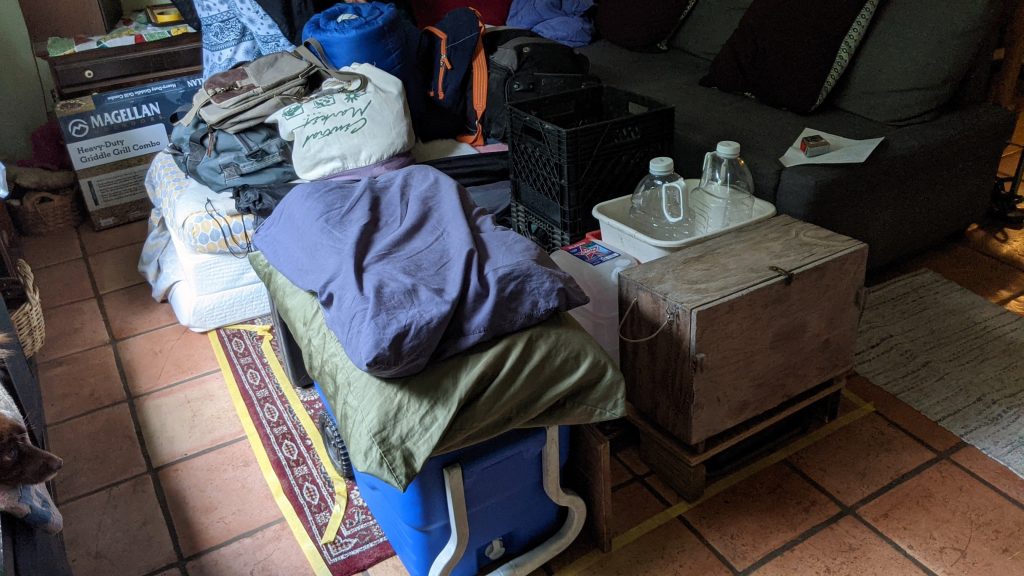

Lists made and checked, Linda’s still-new-to-us RAV4 (Blue Rider) carefully and fully packed, an early awakening, away arrangements made with esteemed house-sitter George Richard Murray, we were as ready as we could possibly be. Bidding goodbye to the cute Foxie dog, we pulled away from Fig Cottage at 9:30 a.m.
We shared driving using the “Tobis Method,” named for our Canadian friends: each of us steered 100 miles before switching. First leg of the trip was to Fort Worth to see our two precious granddaughters and their amazing parents. Stopped at the Bell County Official Rest Area, which features area history exhibits and storm-shelter safe places in that tornado-prone country.
Logan was just awakening from her nap when we pulled in at 12:40 p.m. Into Kristy-Clint’s Honda Pilot we piled and made our way to Press Café, situated along the Clear Fork of the Trinity River. I selected and relished a cheeseburger with home fries and a local pale ale. Harper and Grammy Lina espied a duck family in the nearby stream. Bindweed bloomed there.
Played with the goils in the back yard during our adult happy hour. I swung Harper as high as she could go. Goose their new dog is quite a character.
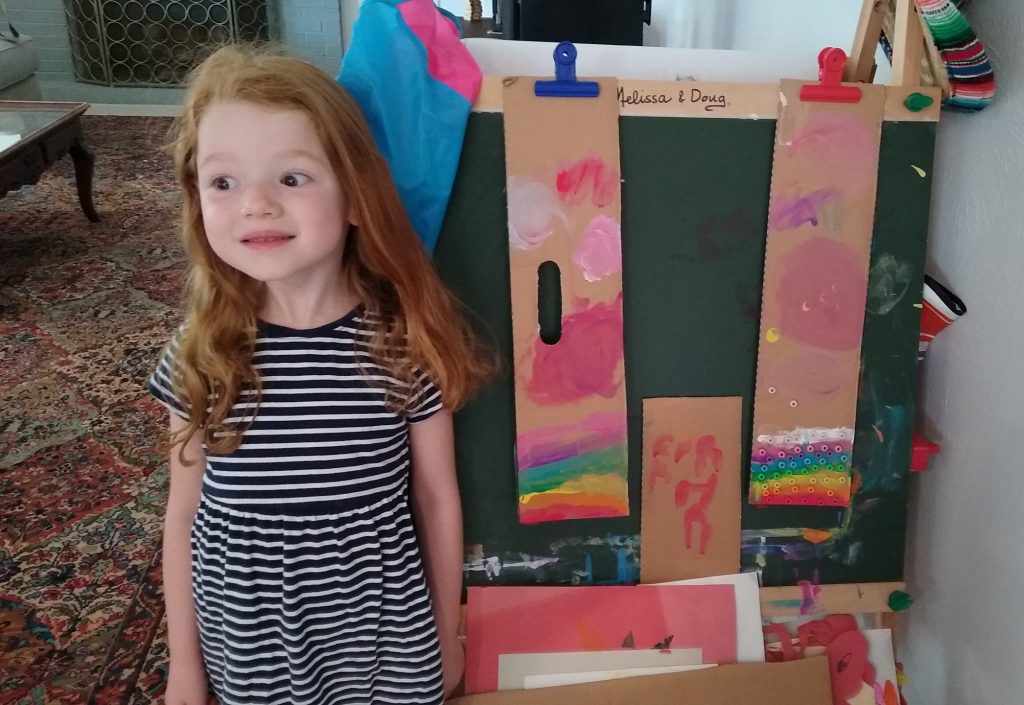

After a feast of chicken thighs, squash, and eggplant and with the wee ones bedded down, we gr’ups (grown-ups) watched a documentary about pop music festivals, beginning with 1967’s Monterey and trending through Glastonbury and Bonaroo. Alas, no mention of Austin City Limits, but the pattern is set.
Sunday, July 11
With no hurry to rush off, we got in early morning snuggles with the kids even before their mom and dad arose. Enjoyed pancakes as morning sunshine streamed in through the kitchen window blinds. Beauty and the Beast was interrupted by Sir Richard Branson’s suborbital send up. We would visit near the area of his space port.
Procured hardware from a home improvement outlet and upgraded my Woodstock chair, tightening its hemp canvas back. After our taco lunch, we rolled over to the neighborhood pool for aqueous fun. It was Harper’s first time to jump from the board. Watermelon and sparkling water refreshed the outing.
Honoring my Middle-Eastern mom, dinner was Syrian food. I helped K cook kibbeh, a traditional meatloaf-like main course, which we served with vermicelli-laden rice. Again with the young bedded down upstairs, we spoke at length about the novel Ishmael and other matters of life and literature. I recommended the movie Wonderwall, but you probably needed to have been there then, 1968.
Monday, July 10
We hoped for an early start, but 8:15 a.m. was good enough. Westward ho! I-20 got us to Abilene by 11, when we stopped at the last HEB anywhere in our direction. Picked up some fresh foods and a bag of ice. Ate lunch out of our food crates and cooler at a travel center in Big Spring. Trees and hills gradually got shorter.
Somehow, I’d managed to explore Texas for a lifetime without seeing Monahans Sandhills. This gap in my travels got handily filled in when we took in the state park just off the freeway. You’d have thought we were on the beach at the coast. Dunes and anchoring vegetation stretched for miles in several directions. Visitors rented snow boards to slide down those slopes. The office operates out of a restored railroad section house from 1903, which in its heyday offered bewildered travelers shelter from sandstorms and where track foremen lived.
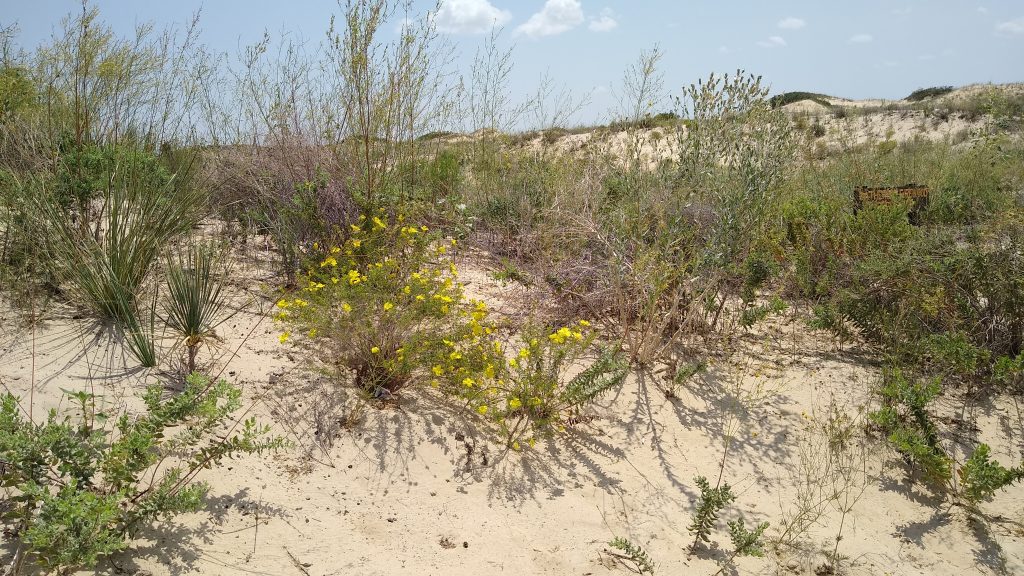
We drove through Kermit in honor of favorite son Roy Orbison. Scenery thereafter offered little in the way of beauty. Instead, all we saw were oil and gas fields and everything industrial that accompanies: derricks, pipelines, high-voltage power lines, equipment yards, tank trucks, roughneck camps, and flairs. Such a steady stream of heavy vehicles doubtless explained the bothersome road construction on RR 652 and its eight or so one-lane delays: 42 miles took an hour.
Guadalupe Peak, at 8,749′, is Texas’s highest, and magnificent El Capitan in front of it isn’t to be missed. We took in this sweeping scene and mused when we might return to camp in that national park. Minutes later, we entered the State of New Mexico and Mountain Daylight Time.

It was a 560-mile day. Carlsbad isn’t much to see, but it offered a filling Mexican food supper at El Jimador and a cheap Motel 6.
Tuesday, July 13
Flies in the room woke us up. Ate cereal, drank gourmet instant coffee made from tepid tap water. Departed at 9:35 and retraced our route SW to White’s City and trended westward to the headquarters of Carlsbad Caverns National Park. Even though we’d both been there before in our previous lives (but never together), we were amazed at the beauty. Hiked down, down, down through the natural entrance and oo’d and ahh’d a journey to the center of the earth 750′ below the desert. The tour was self-guiding. Once back in the broad daylight, we enjoyed a tailgate lunch in the parking lot.
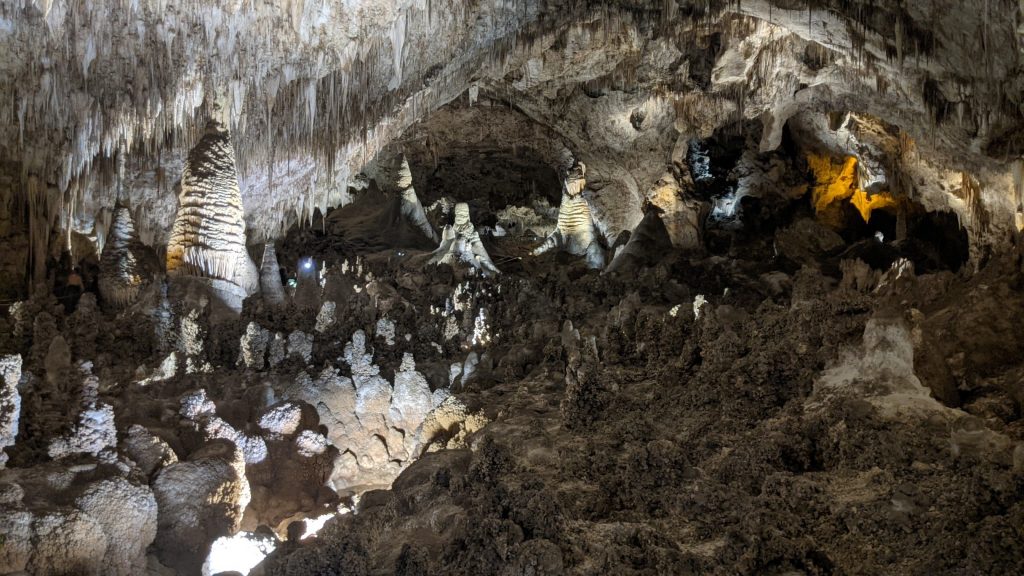
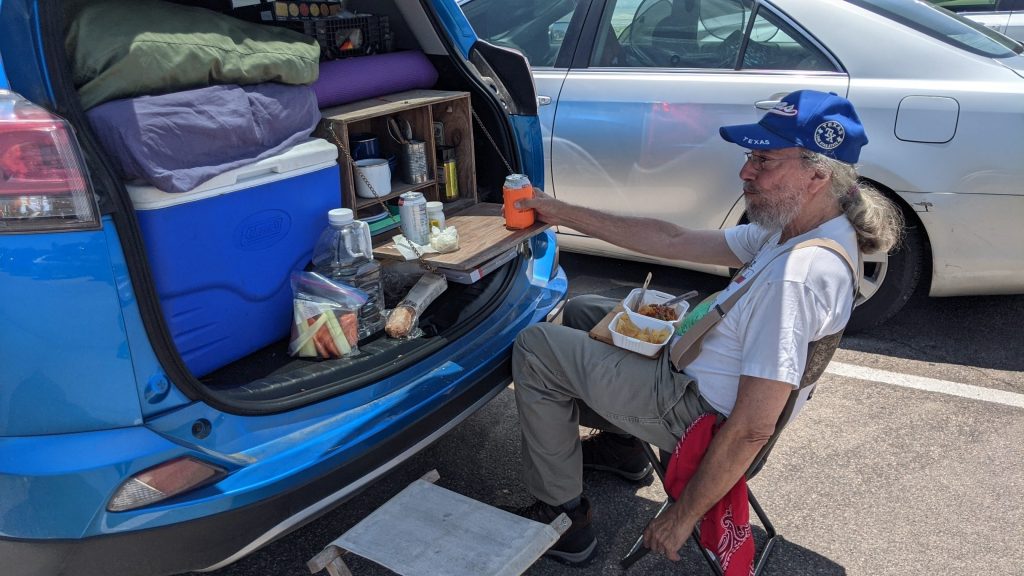
Followed the Guadalupe Mountains, their Lincoln National Forest, and the Pecos River to Artesia’s extensive pecan orchards. Turned westward onto Rio Peñasco Road (US 82) and watched the landscape soar from parched plains into juniper, pine, and mixed hardwood foothills. Palisades along the way recalled those of our familiar Davis Mountains.
Suddenly came Mayhill with its post office, store, hotel, and café. There we found the place we’d reserved to pitch, The Camp @ Cloudcroft, even though that town was a good 23 miles ahead. We checked in with Chip, the camp host, who helped us position the picnic table at our assigned site. We commenced to unload.
The privately owned campground features a dozen tent sites, 35 RV slots, some glamping structures (teardrop trailer, wall tent, bell tent), bathhouse, two pavilions, and a levee that holds back the Peñasco. It’s shady and offers mountain views. The outhouse boasts a flush toilet and tiny sink.
For our Camp Patchouli, we strung the Green Man tapestry between two trees and situated our instant cabin tent between that and the table. We left the chuck box and cooler in the vehicle, all easily accessed. The new memory foam mattress made sleeping a dream. Most of the neighbors were friendly, and several complimented our setup.


Walked into town and lugged back a sack of ice from the wee convenience store. New Mex is an open-carry state, and we soon got acclimated to seeing clerks and hikers packing heat.
Salad chased with beer and wine made a fine supper. All was peaceful for our first night in the cloth house.
Wednesday, July 14
We woke up to a delightful and dewy 62°. Besides coffee, breakfast consisted of bacon and warm granola with blueberries and apples. When we can, our morning routine includes journaling and sketching. Hoping it was a feeder, a hummingbird buzzed the red lantern hanging over the table. Overnight, some critter found the flimsy garbage bag that I shouldn’t have left within reach.
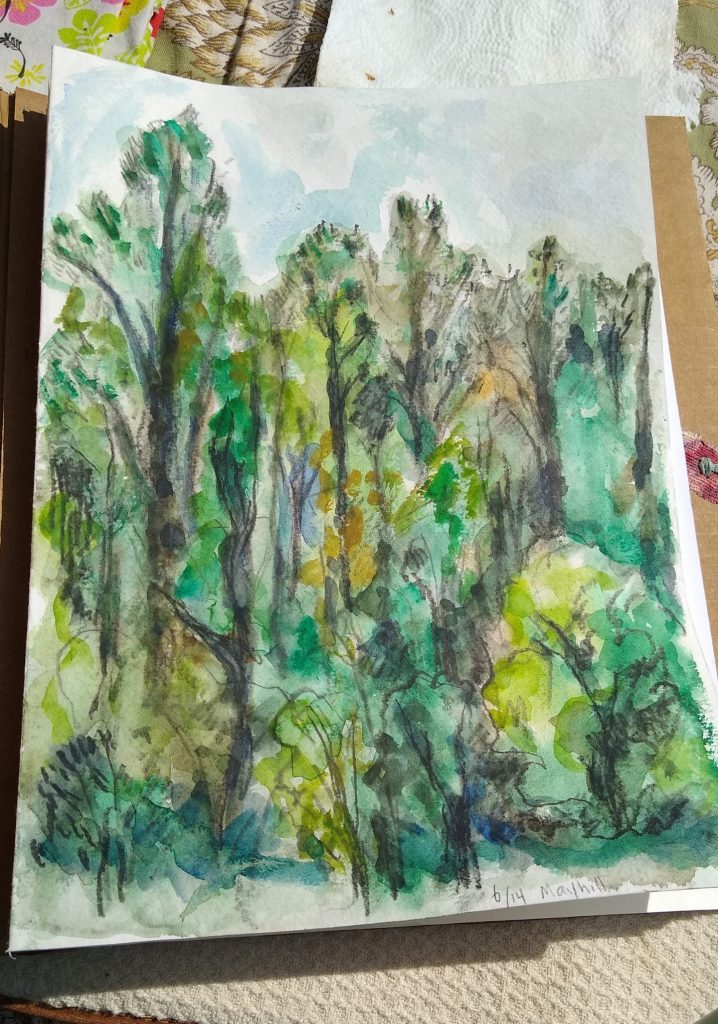
Mid-morning saw us cruising west on NM 130, our camp host’s suggestion for a scenic route to Cloudcroft. Passed Dark Canyon and wondered if that was one of the Three Musketeers. Saw scars from recent forest fires.
Just before getting to town, we steered southwest on NM 6563 to Haynes Vista, where we beheld the snow-like White Sands way off in the distance. Tularosa (red reed), the area west of the Sacramento Mountains, is geologically an endorheic basin, meaning that any water from streams flowing into this low point will not make it to the ocean. For reference, Rio Peñasco flows into the Pecos.
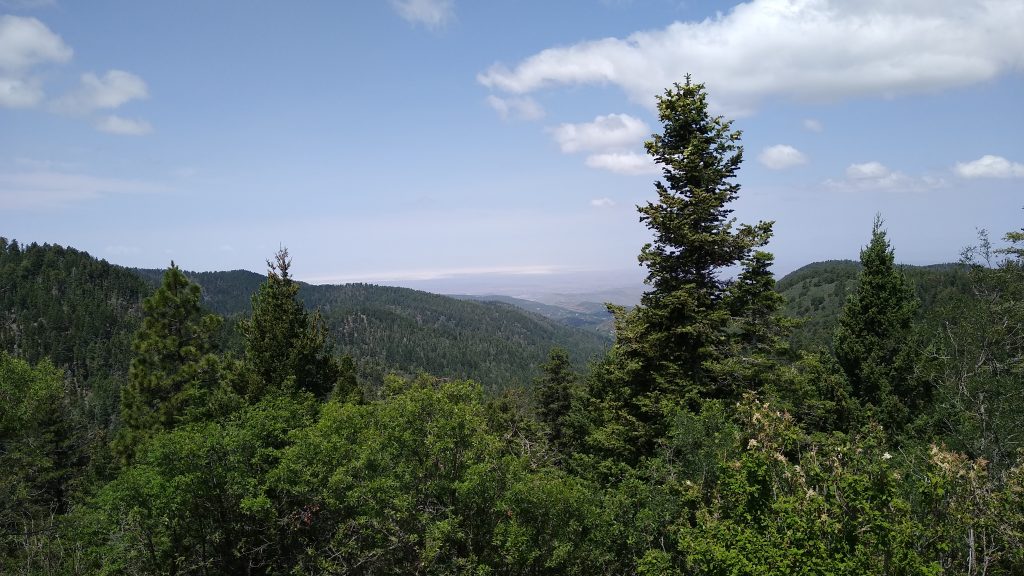
An astronomical observatory here set up a scale model of the solar system. If Sunspot, NM, were at the center, Neptune would be close to Haynes Vista and Pluto would occur at the Cloudcroft Chamber of Commerce—about 12.5 miles as the crow flies.
Parked on Burrow Avenue, the main street in Cloudcroft. Did a moonwise circle around and through the diverse shops, gaining valuable hiking info from the High Altitude outfitter store. Plenty of trinkets to refuse. Tried in vain to get seated at Dave’s Café (way too busy) and were put off at a sandwich deli when the door wouldn’t close itself and the cashier yelled at customers to shut it.
One item I’d forgotten to pack despite our extensive checklists was the charging cable for a replica hurricane lantern that Sol had given me for retiring. The outfitter had no such thing; nor was Family Dollar any help in this regard. We did, though, procure excellent pulled pork next door at Texas Pit Barbecue, which is run by a family from Marble Falls. No, we didn’t travel all the way to southern New Mexico to find Lone Star State cuisine per se, but the food excelled.
Checking radar on our phones, it appeared that a sudden thunderstorm was brewing over Mayhill. We’d forgotten to close the tent windows! So much for experienced campers. Options were to run back east and deal with wet bedding or to continue our scheduled walk in the forest. We chose the latter.
On the town’s western edge is a reconstructed train depot that marks the beginning of a trail to Mexican Canyon. This was the debut outing of my new boots and Lina’s pair of hiking sticks. It’s 1.25 miles up and down to an old wooden railroad trestle. Nothing beats the aroma and good energy emanating from conifer/hardwood timberland. We were way overdue for an immersion in forest bathing.
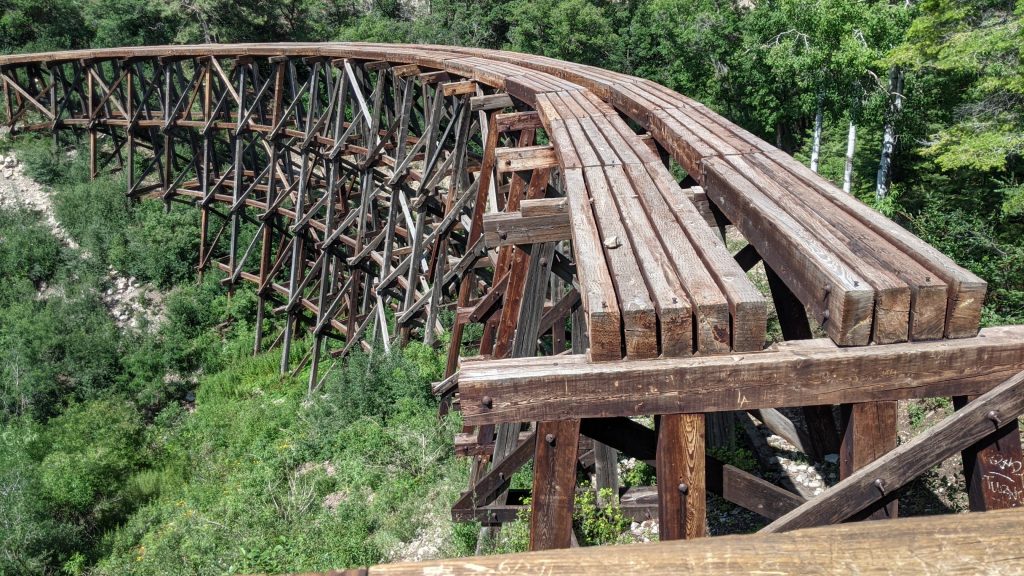
Back at the campground, imagine our delight to learn that not a drop had fallen all afternoon. We handily dodged that bullet, but learned a valuable lesson about the unreliability of weather forecasts in a mountainous region. Hiked around the grounds, discovering the many glamping sites available there: hogan, teardrop trailers, pyramid tent.

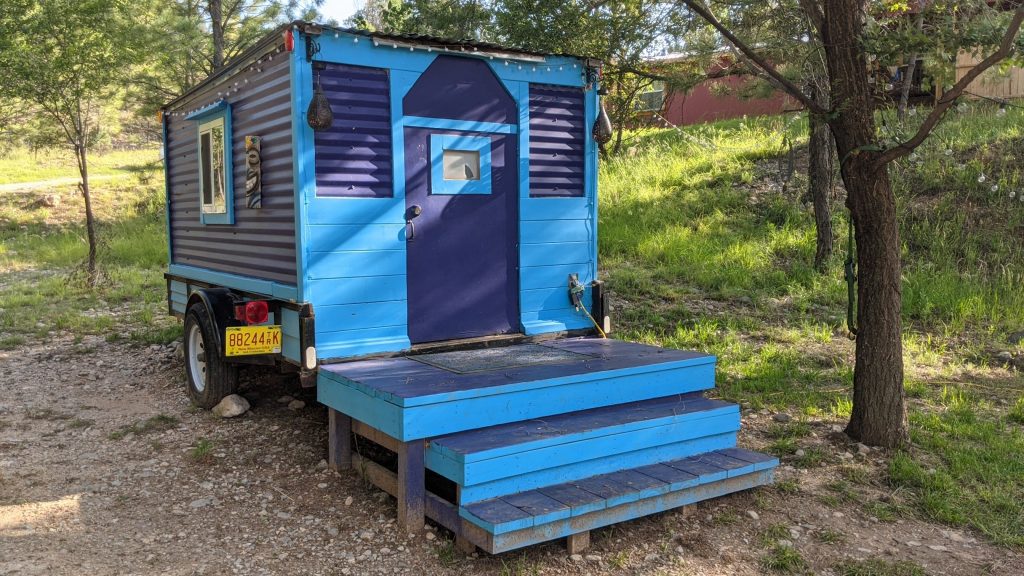
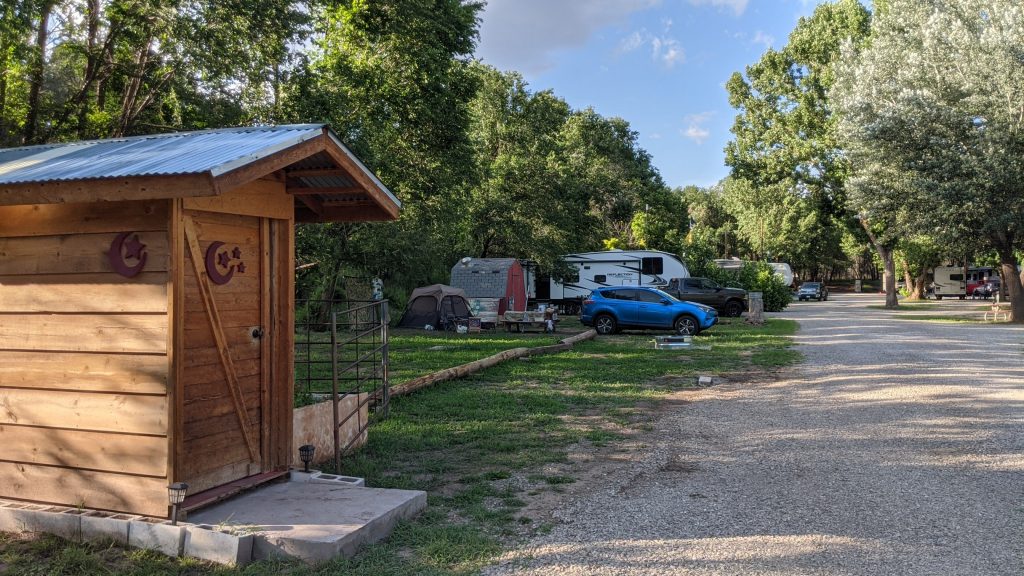
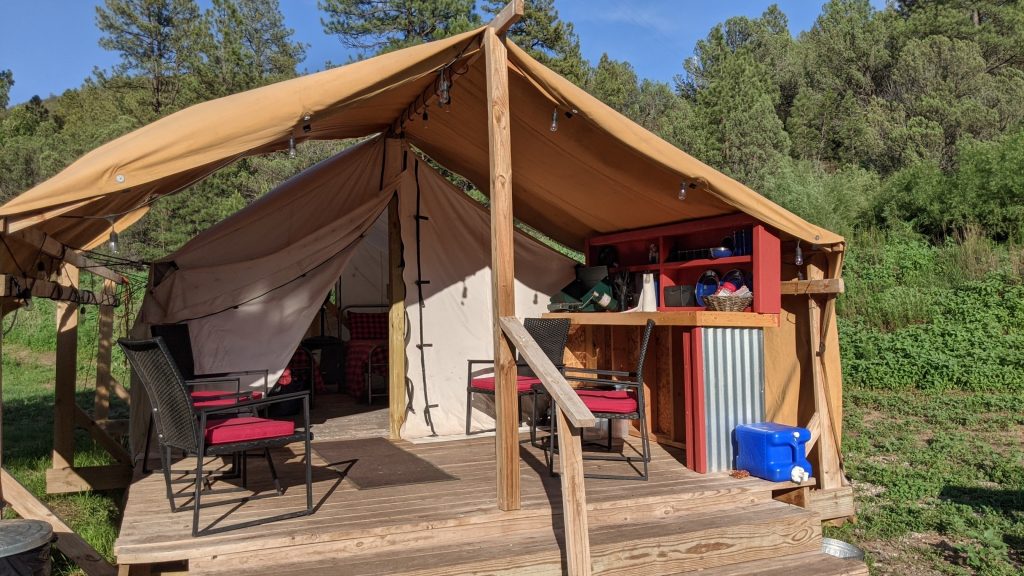
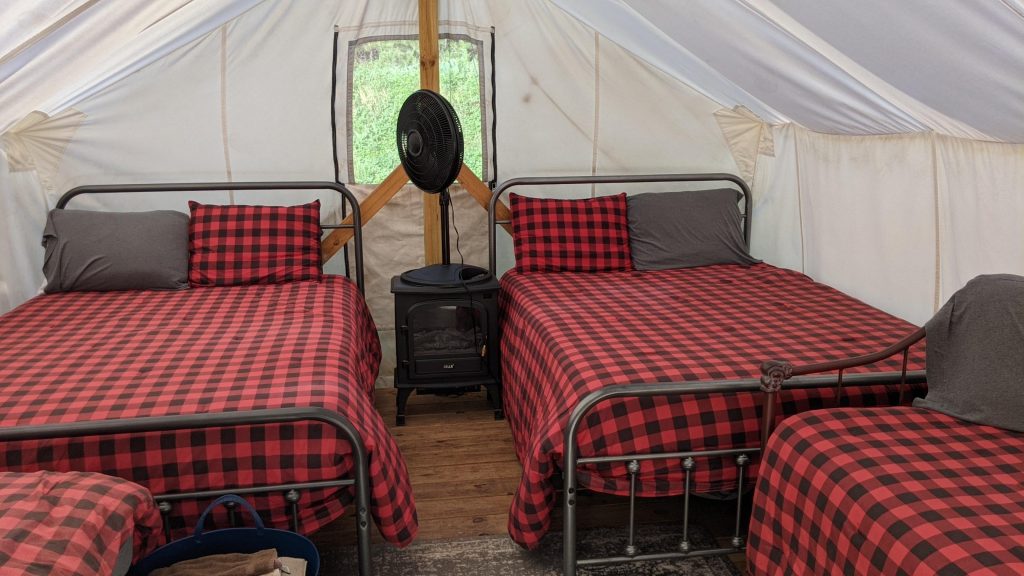
Supper manifested as avocado toast with sparkling beverages. Sleep.
Thursday, July 15
A crisp 61° roused us from slumber to begin our morning repast and pack up the Conestoga. The rest of the camp came alive as well with plenty of vocal children. Rolled away at 9:45.
The highway west of Cloudcroft dips 4,000′ in 20 miles, a challenge for 18-wheelers. There’s a way-cool tunnel, too. We’re impressed with New Mex’s road system, especially how pavement-edge signs indicate passing lanes. More states should install these aids.
Alamogordo appeared kinda creepy. We refueled there at a sad convenience store. Onward south and west, we soon came to White Sands National Monument and enjoyed free entry. Overcast skies muted the brilliance of this whiter-than-white gypsum landscape. Like at Monahans, folks used plastic disks to surf down sandy slopes. We strode out on a boardwalk and snapped some selfies.
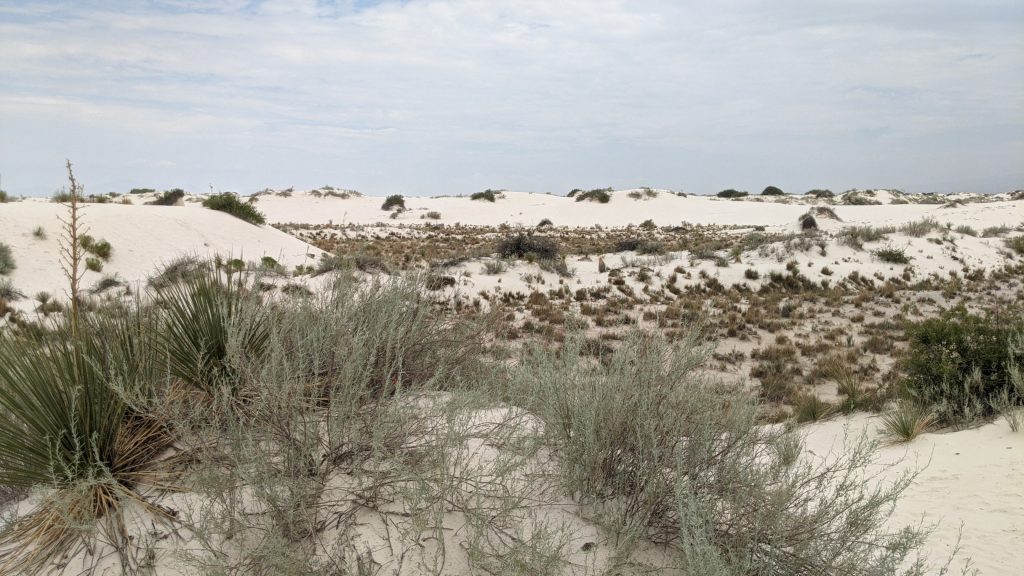

Retracing the route and thankfully bypassing Fat Cottonwood, we continued up US 54 to Pistachioland, a magnificent tourist trap of a roadside attraction. A pistachio orchard thrives here thanks to irrigation. Ravens love to cavort between the rows. For sale was every conceivable flavor of pistachio plus inconceivable ones. For the trouble, I came away with a small bag of regular roasted nuts.
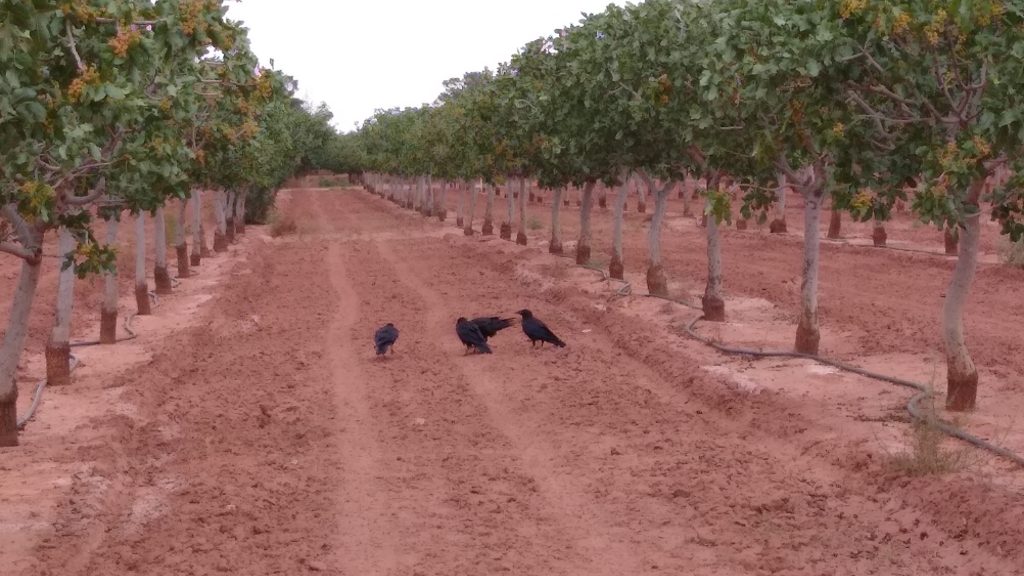
Next stretch took us along the Tularosa Valley, framed by the Sierra Blanca range on the east. It’s a rather ordinary high desert plain, about 1,500′ in elevation. The only town of any size to relieve the sameness was Tularosa itself, famed for its venerable irrigation system and resulting big cottonwood trees. After an hour, we approached “Zozo.”
The name Carrizozo translates as place of abundant reed grass. After its railroad-glory days, barely a thousand souls now call this seat of Lincoln County home. We pulled into a Valero station for fuel and cold drinks and found shade near the diesel pumps for a stand-up tailgating snack. Had we paid attention to our maps, we might have opted for a more pleasant pausing place just up the road.

I remembered Valley of Fires State Rec Area from the family’s 1989 visit, but forgot that we’d camped there. This time, my companion and I spent a few minutes taking in the scenic view from the park’s overlook. This could well be the most recent lava flow in the continental US, dating from perhaps 5,200 years ago. Colloquially, the field is called Malpais, or badland. It would be a rough walk for a horse through such a broken landscape, so early explorers simply went around it. The black basalt here made fantastic swirling and contorted shapes as it cooled.
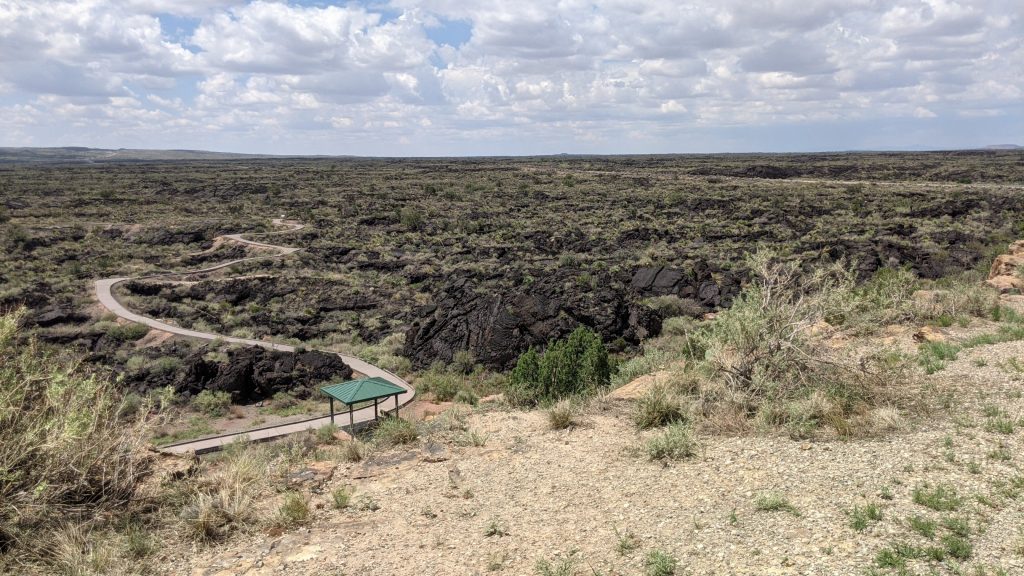
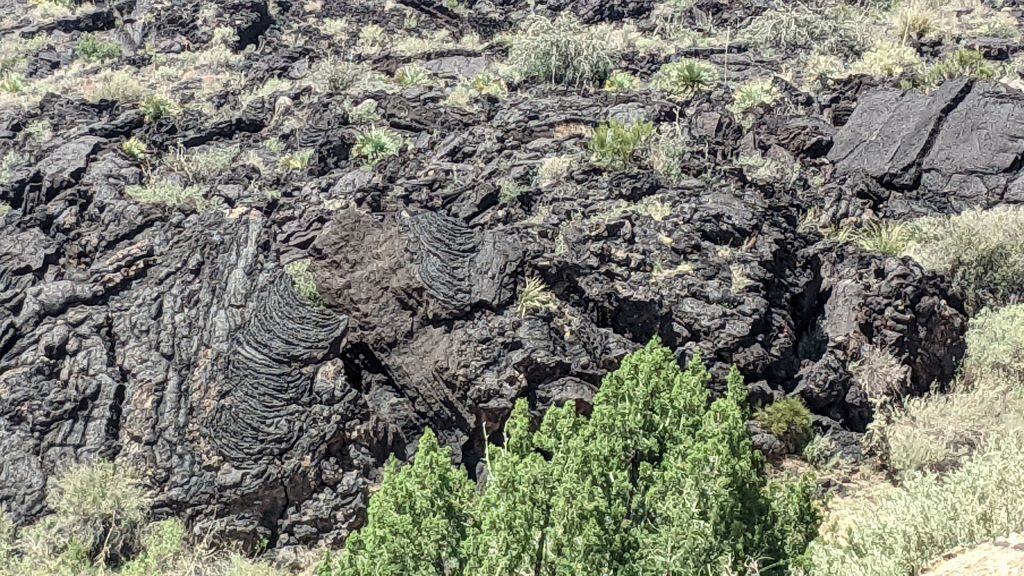
Several old-looking signs indicated that our next stretch of highway was closed due to weapons trials. Not true. A nondescript NM historical marker told of the Trinity Test, where the nuclear era began. The actual site of the first atomic bomb explosion is open to visitors only a couple times a year, neither close to the date we sped past.
Many foothills later, we wheeled across the mighty Río Grande into the teeny village of San Antonio, with its population of less than 100. First glimpse of the community revealed its poverty. New Mex is a poor state to begin with, and offbeat places such as this exemplify why and how. A major source of commerce here is agriculture, thanks to irrigation from the river. Second is tourism: a good-sized wildlife refuge downstream attracts birders during migration seasons. One bed and breakfast is listed officially, and several dwellings are otherwise rented out.
Another of the burg’s claims to fame is as the birthplace of hotelier Conrad Hilton on Christmas Day in 1887, a quarter of a century before New Mex’s statehood. His parents had run an inn there in those early days. Coincidentally, Conrad’s first purchased hotel sits in Cisco, Texas, through which we had flown on I-20 between Ft Worth and Abilene.
Patty warned us that her dwelling looked like the ruins on either side. Except for some visible wall and roof cracks, the front of 14 Church Street seemed OK. She texted us to come ‘round the back. There she greeted us with hugs and squeals of delight, then showed off the well-appointed kitchen, bedroom, living area, and bath. We settled in. Lina and Patty took time to catch up around the kitchen table against shelves artfully displaying Patty’s hand-thrown pottery and coneflowers in a vase. It had been close to 15 years since they last met. This adobe had been Patty and husband Benson’s ongoing fixer-upper until he took ill in the early 2000s, whereupon the family (including daughter Zoë) had to move to Santa Fe for his care. Alas, Ben sloughed off this mortal coil in 2011.
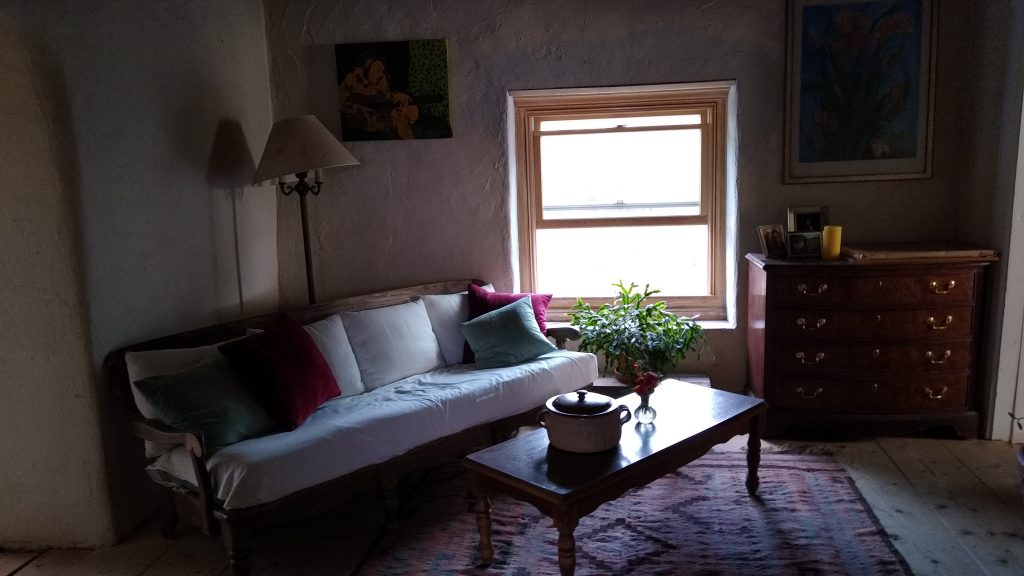

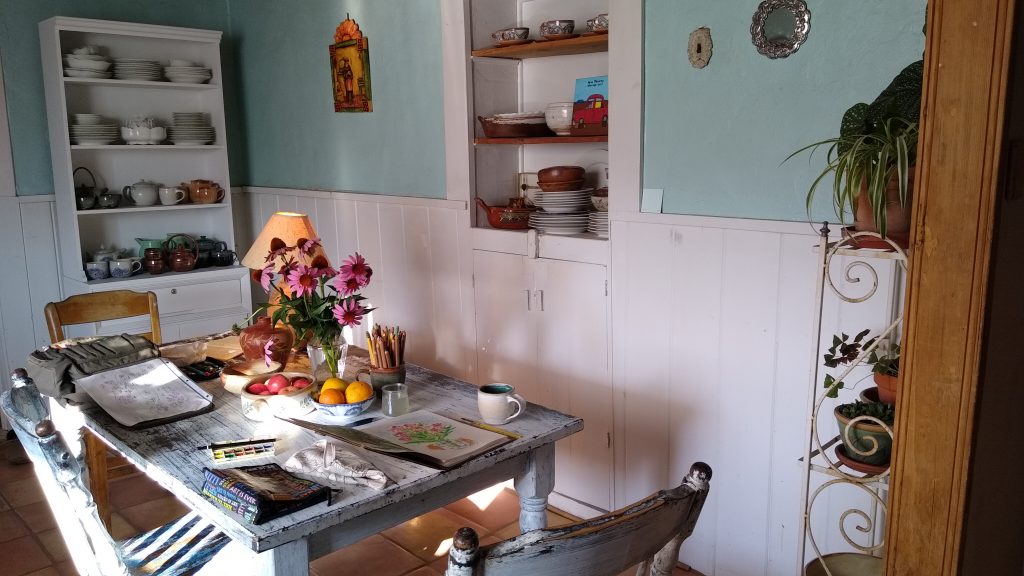


Walked to the Owl Bar and Café, ca. 1945, which claims to be home to the original green chile cheeseburger. Mine was yummy, with French fries and a Dos Equis. Linda and Patty relished beans with green chiles. Decor and menu are frozen in time. The wooden bar itself hails from the Hiltons’ first rooming house, a stone’s throw down the street. In 1945, a group of “prospectors” frequented the place and requested the Owl’s owner to cook them burgers. No one suspected that these transient customers were nuclear scientists, working on the Manhattan Project.
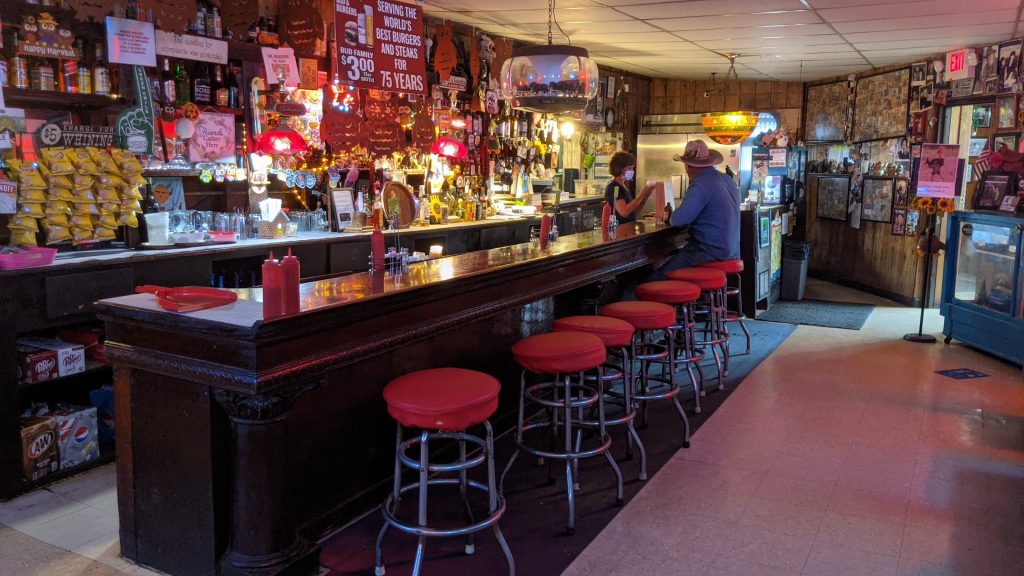
Our hostess filled us in on more of the town’s history. Another establishment, the Buckhorn Tavern, a long block from the Owl, also claims to have invented the chile cheeseburger. A kind of friendly rivalry exists between these businesses, and I’ll need to try the Buckhorn’s version to make a formal judgment. New Mex tourism publishes a green chile cheeseburger trail that features 60 (six-zero) burger joints, each with its own expression of this fine cuisine.
Back at the casa, Patty left us to our own devices, returning to her late dad’s house up in Socorro. We settled back into comfy quarters after an eventful day. The sit-down shower refreshed.
Friday, July 16
After our waking repast, L and I explored the neighborhood on foot. Nearby are a tidy-but-closed bed and breakfast and a fenced-off church. Chatted with one Gary, who lives close by, asking about the peacock-like call we were hearing. He thought it might be a dove.
Couldn’t help snooping around the unfinished rooms in the house. Stored there were attire, footwear, dismantled furniture, tools, construction supplies, and books. A jack held up a broken beam in the roof. The yard was also stacked with raw materials and stockpiled resources, amounting to one huge ongoing project. Mosquitoes were abundant. We were grateful for the functioning and pleasant areas.
The ever-cheery Patty collected us in her Subaru wagon at 10:00 and steered us along the “scenic route” (NM 1) north to Socorro, population 8,500. Parked at the plaza and strolled between historical photos of the town. Our hostess told each building or vacant lot’s story; a fellow in the square acted as an impromptu guide, adding other tidbits. In the M (for mining) Mountain Coffee shop, a friend related tales of Red River, NM (a destination in our future), and its less-active-than-in-the-past music scene.
Next came San Miguel’s church. Obtaining permission from the priest, we reverently entered the sanctuary for photos of the well-preserved religious figures, including Jesus in the tomb.
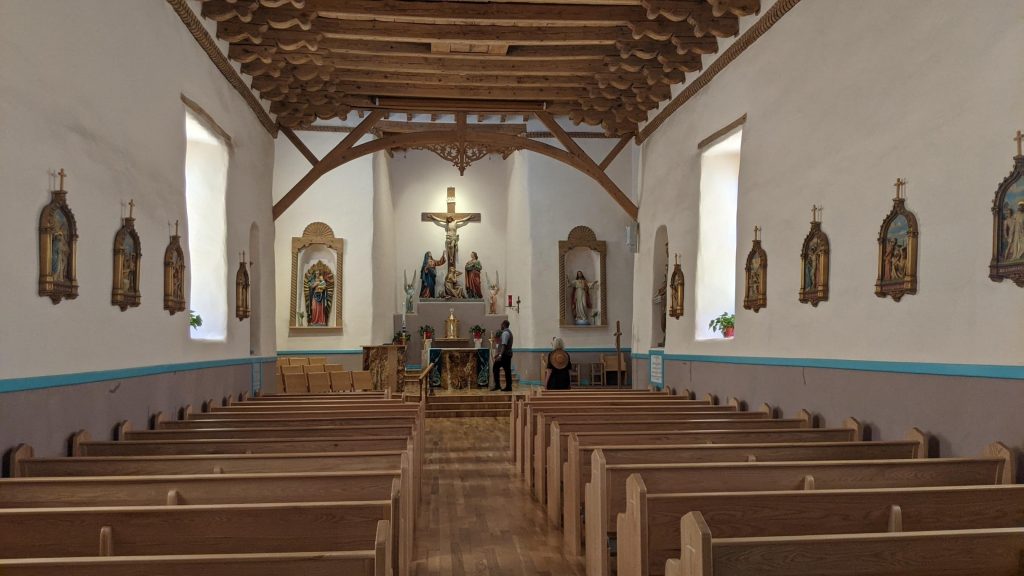
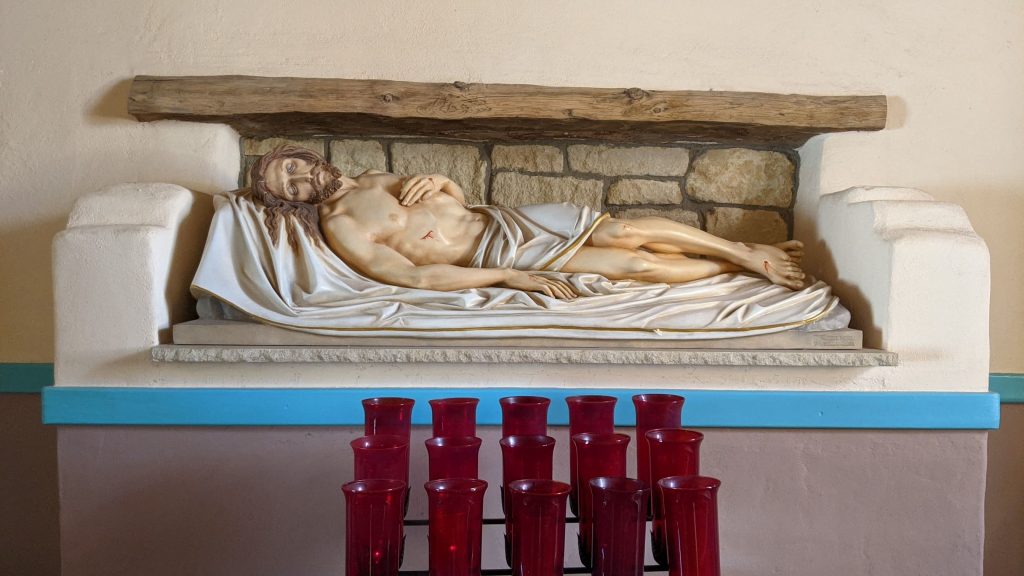

Tracing a circuitous route, we got to the lush campus of New Mexico Institute of Mining and Technology, where Patty’s dad had been a professor of organic chemistry. Here is the state’s Bureau of Geology and Mineral Resources, whose gift shop sold me a road and recreation atlas and a geologic highway map of New Mex—both highly sought-after. Across the atrium is the fab Mineral Museum, which shows case after case of brilliant crystals of every hue from around the state and world. Remarkable were samples of Trinitite, desert sand fused into rock when the world’s first atomic weapon lit up the early morning of July 16, 1945, just up the road from where we were, exactly 76 years to the day before our visit.
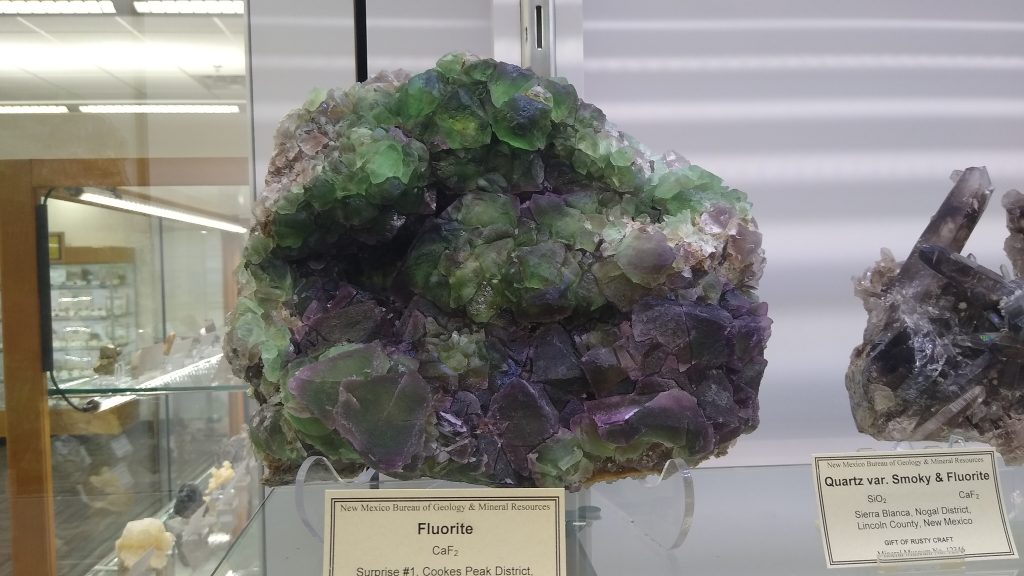
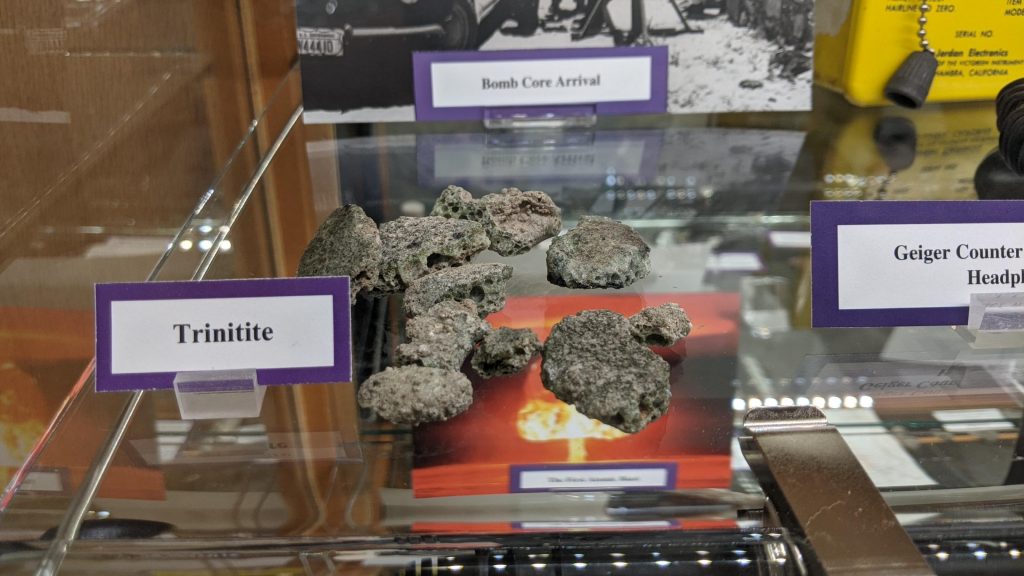
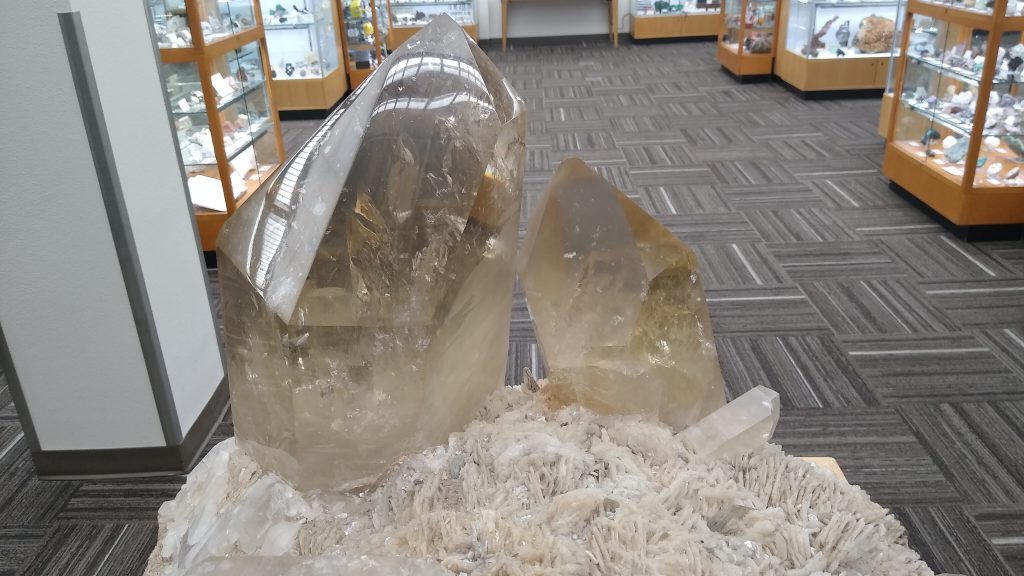
Lunch: El Sombrero introduced me to New Mexican stacked enchiladas. They contain ingredients similar to the rolled kind, but are prepared more like lasagna. Wherever you dine here in the Land of Enchantment, you get asked the salsa question: “Green or red?” You might prefer both, or “Christmas.” Patty clued us in on the wide variety of green chile types around the state, each offering a distinct gustatory sensation. The soil and climate of every locale make that pepper’s unique taste. Hatch chiles, for instance, are grown only in the Hatch Valley.
Let’s visit a nearby quaint village! Off we went to Magdalena, some 27 car miles west and a thousand feet higher in elevation than Socorro. This 653-person burg encapsulates most stereotypical Western themes: cowboys, railroads, mining, saloons, ghost towns. Its namesake is a prominence in which many imagine the face of Mary Magdalene, but we had trouble seeing her. We’d hoped to visit a print shop there, but it appeared defunct. Evetts Café in a former bank building awakened our sensibilities with iced coffee and strong tea.
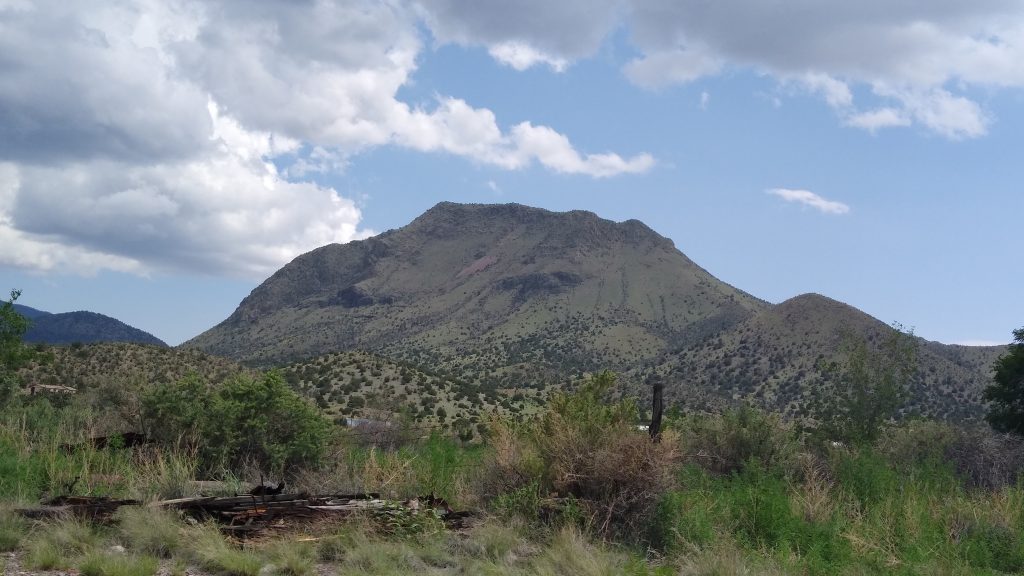
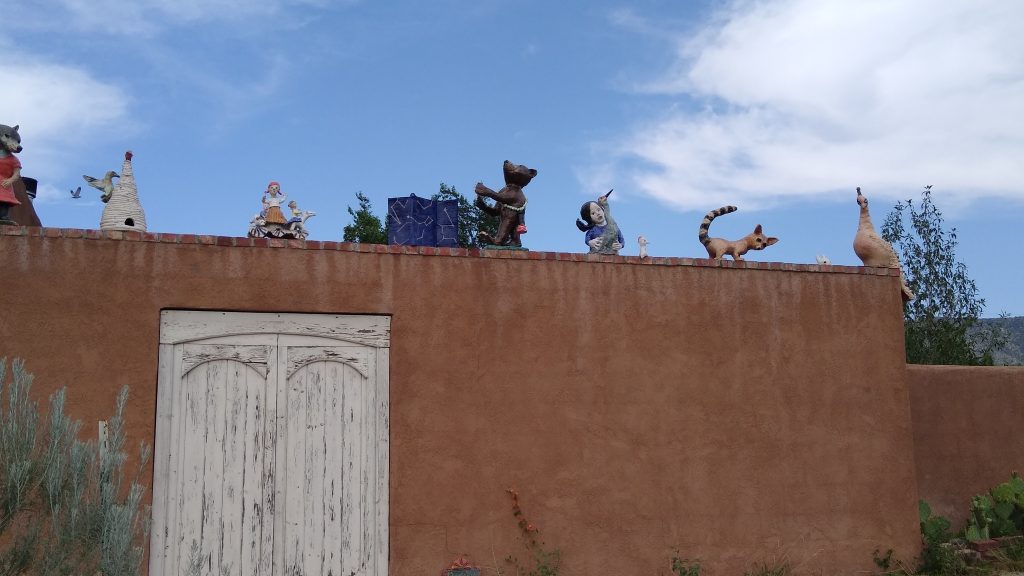
I requested mountains and trees, so Patty obliged with a side trip to Water Canyon. Palisades there recalled such in the Davis and Chisos Mountains back home. The U S Forest Service provides a vault toilet, group pavilion, pack trails, and primitive campsites. We hiked up the wash and found a cool running stream, alligator and blue juniper, ponderosa pine, wild cherry, and walnut. An open meadow invited tents, we so noted.
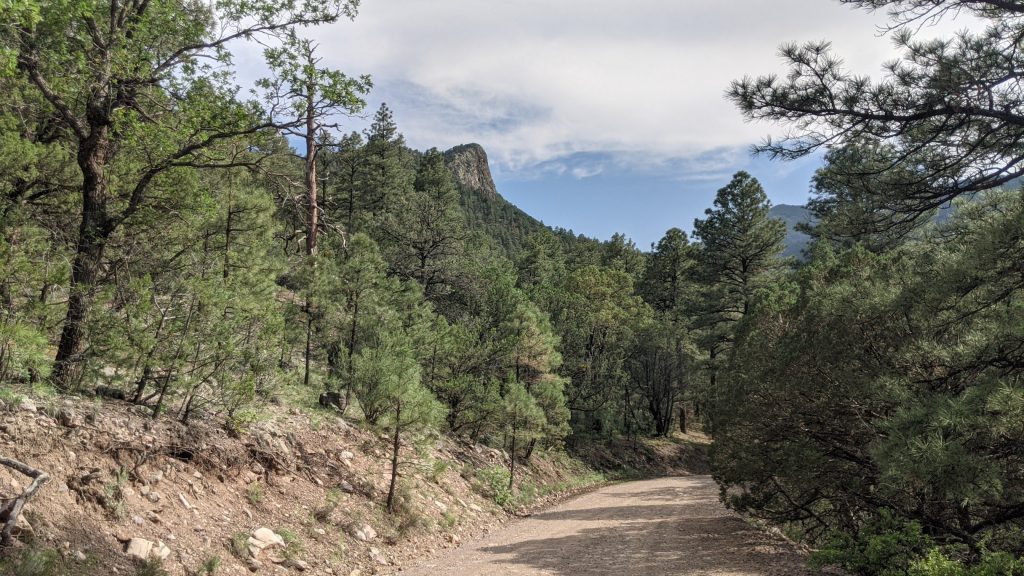

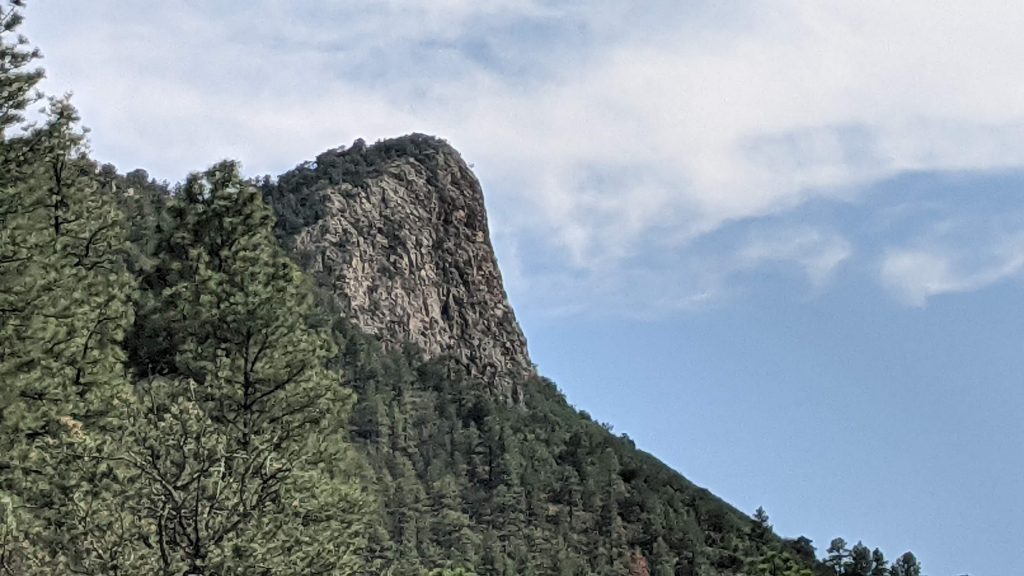
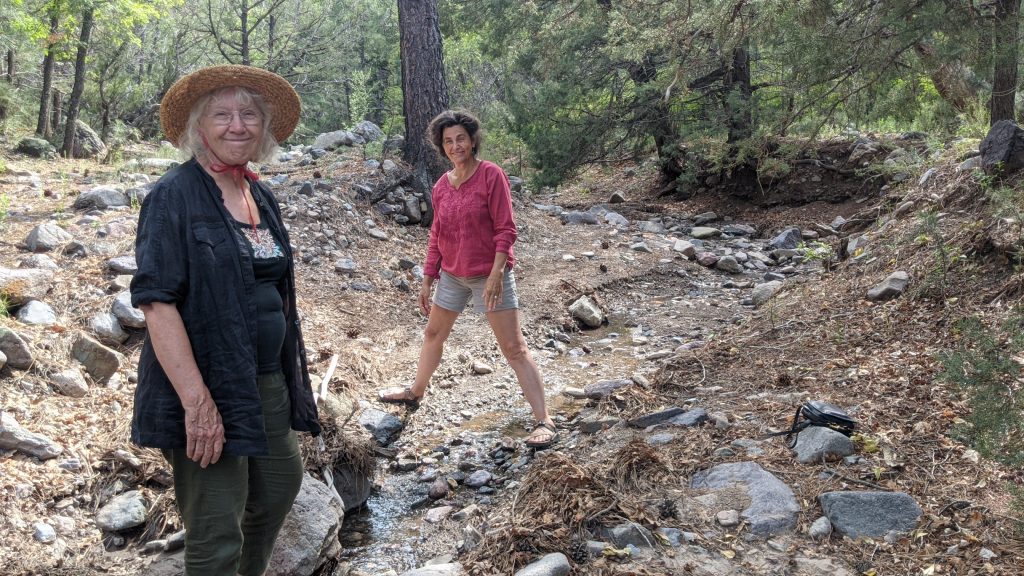
The Box, as in box canyon, is a favorite BLM rec area to rock-climb and rappel. It could also have been named The Widow for its view towards Black Mountain. I appreciated bright lichens growing on those igneous rock surfaces.
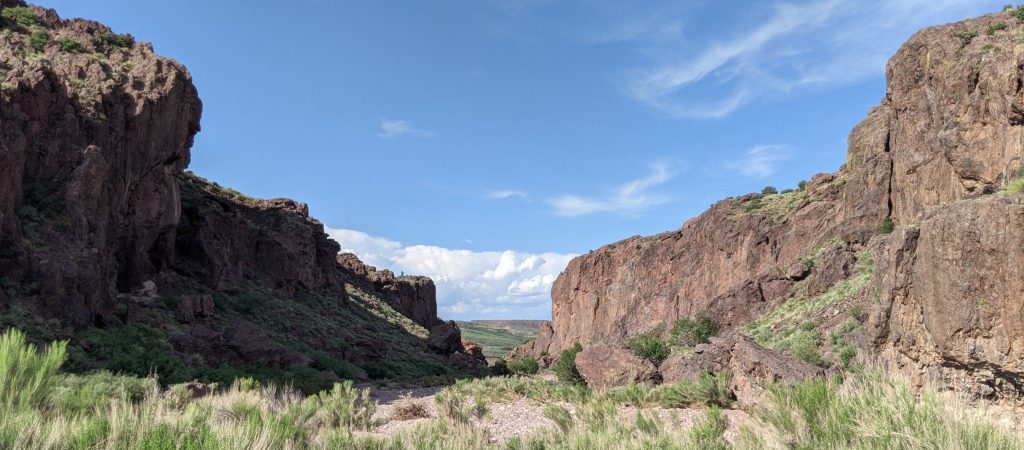
Back in Soc, we randomly circled some more until ending up at Patty’s childhood home, which stands in a neighborhood where many of her dad’s fellow faculty lived. She remembered that everyone was named Doctor. With both parents gone and her only sibling living out of state, it’s Patty’s task to clear out 40 years’ worth of memorabilia and list the house for sale. It’s a monumental chore.
Returning to the adobe, we feasted on beans, greens, chiles, beer, chips, and P’s sweet rose hips wine.
Saturday, July 17
Up ‘n’ at ‘em to pack up our entire kit in the Blue Rider. A specially padded box held a precious set of cups and saucers for a friend in Central Texas who had coveted Patty’s near-perfect pottery. Putting the dwelling back the way we’d found it, we ventured north on I-25 to Socorro and met our dear friend in the same near-plaza coffee shop. Patty treated us to beverages and green chile cheese croissants. She also gifted me with a vintage architect-style clamp-on lamp that had been her dad’s. We could have yakked all morning, but the open road beckoned. Hugs later, we fairly flew up the interstate.
Aside from admiring its artsy over- and underpasses, our only interest in Albuquerque was its interchange to I-40, the former Route 66. That led us east to Cedar Crest, where we curved left to NM 14, a.k.a. the Turquoise Trail. This official National Scenic Byway took us past the east edge of the pine-studded Sandia Mountains and out into more typical juniper-strewn desert landscapes at no more than 50 miles per hour.
When a sign said Congested Area, we knew we’d made it to Madrid (pronounced MAD-rid). The former mining ghost town densely lines the highway with scores of shops, galleries, eateries, cantinas, and boutiques. Many of the century-old structures, now gaily painted, had been moved in from Topeka, Kansas, as prefabricated miners’ cabins when anthracite coal was all the rage. Crowded on this bustling summer Saturday, we parked along the main drag and found refreshment in Jezebel’s studio and soda fountain: green chile French fries and cola.
Our good friend and favorite author Daniel Quinn and wife Rennie lived here for some seven years in the 1980s. It was here that he began writing the book that would become Ishmael, the work for which he’s most famous. We looked for remnants of those early years. Rennie suggested we visit the Johnsons (no apostrophe) of Madrid gallery and say hi to Dan’s granddaughter. Alas, despite being on a weekend, the place was closed.
Onward, ever northward. In Santa Fe lives Lina’s paper-conservator friend Lysa Allen, who moved there from Austin three years ago. She graciously opened her art-bedecked address to us for a couple nights. Even this suburb of the City of Holy Faith presents regional charm, and Lysa’s property might as well be a gallery in its own right. Inside are the requisite kiva fireplace, paintings, sculptures, prints, furniture, and a couple kitties. The outside features a Zen garden and pond, lanai, and flower plantings.
We got situated, walked the nearby neighborhood, feasted on guacamole, drank cerveza, and washed the day off our weary skins.
Sunday, July 18
Lysa’s was a pleasant place in which to awaken that sunny morning. Both cats, a big furry gray and the other pale-yellow slim, leered at me from an interior window between the living room and kitchen. A long table made of two colors of beaded paneling supported my travel log notebook as I sat on an orange metal chair. All these furnishings are antique-like or Santa Fe Southwestern. Several solar tubes let in eye-opening daylight into rooms on this end of the house. Lysa and Linda conversed around coffee on a glass-topped table outside. Sets of wind chimes sent melodies into the cool morning air. City sounds provided a dull roar beyond the garden walls.
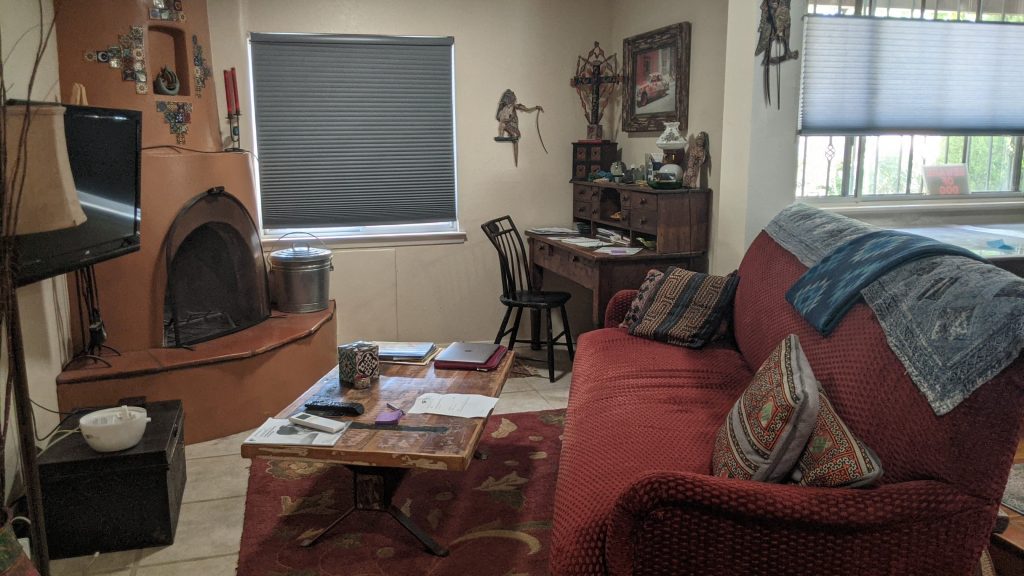
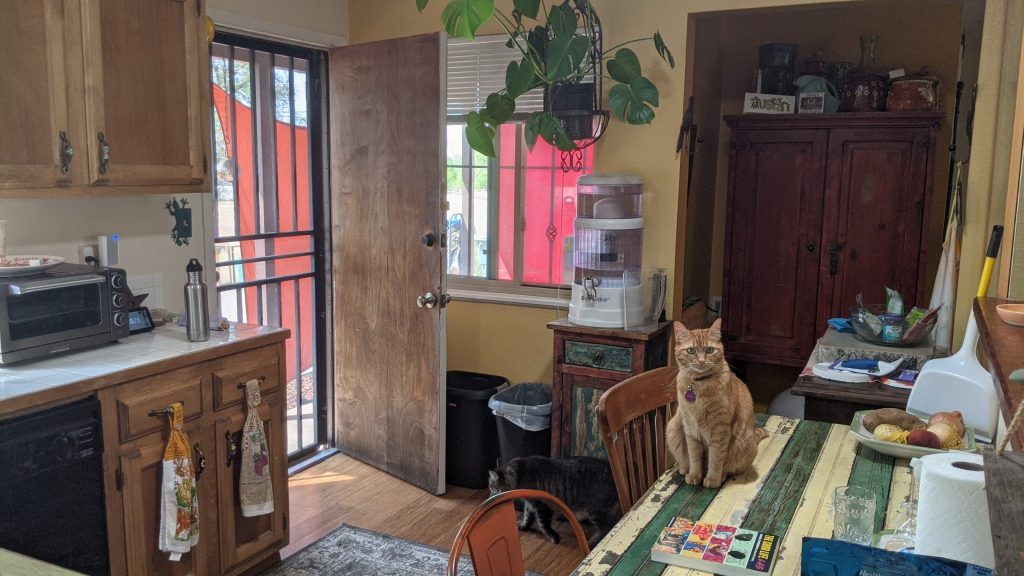
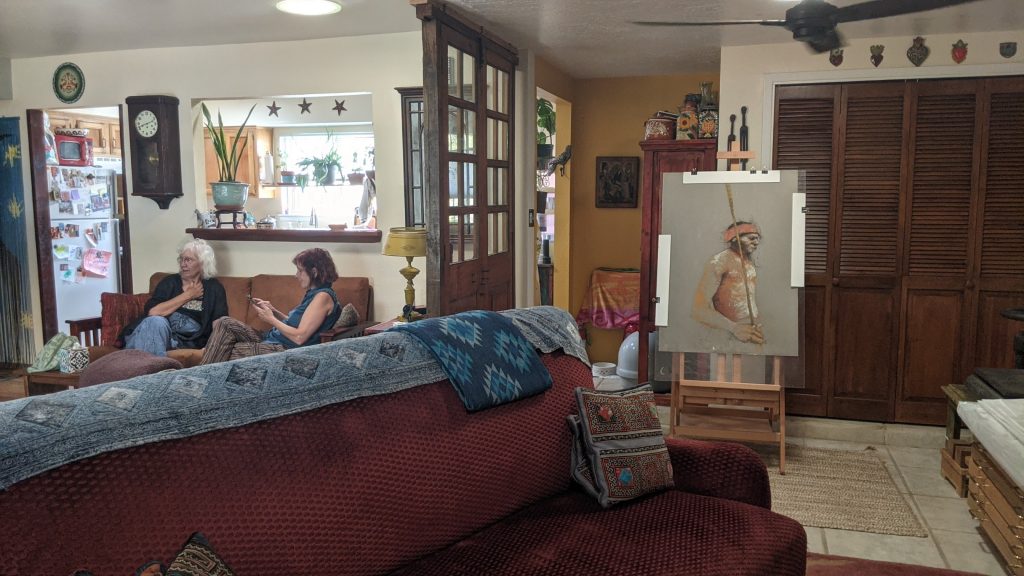
Dressed, we ate a frittata improvised from our accumulated leftovers. Piled into Lysa’s Subaru and headed towards the heart of this City Different, which I soon renamed City of Compounds for its distinctive alleys and house clusters. Parked on Alameda along the Santa Fe River, crossed over on Delgado, and strolled Canyon Road’s plethora of shops and galleries. Ate apricots fresh off the tree at the Tibetan Center, which also displayed shiny metal whirligigs and similar dynamic sculptures. Every bend in the lane presented more iconic architecture and pleasing plantings. One gallery/studio/residence was for sale for a mere $999,000. Ate mac ‘n’ cheese at the Teahouse and took out half of a veggie wrap. Rain came down on us during the hike back to the vehicle. I didn’t see him, but my friend Will Taylor from Austin drove past us and sent me a text to that effect.

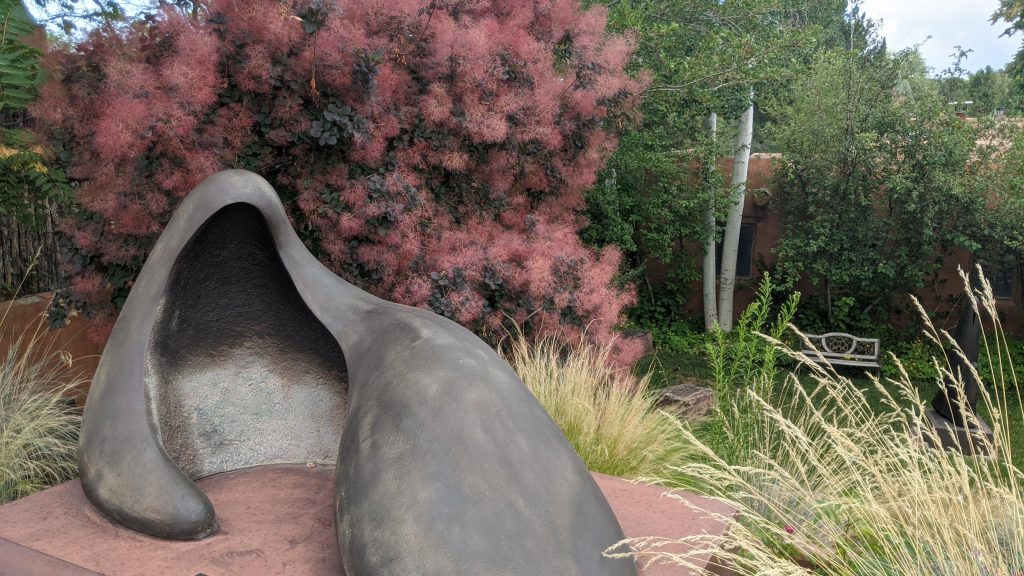
Hurriedly rested, then bee-lined it to Meow Wolf: House of Eternal Return. A funhouse decorated by an artist collective, it was truly a trippy experience. Rested again?


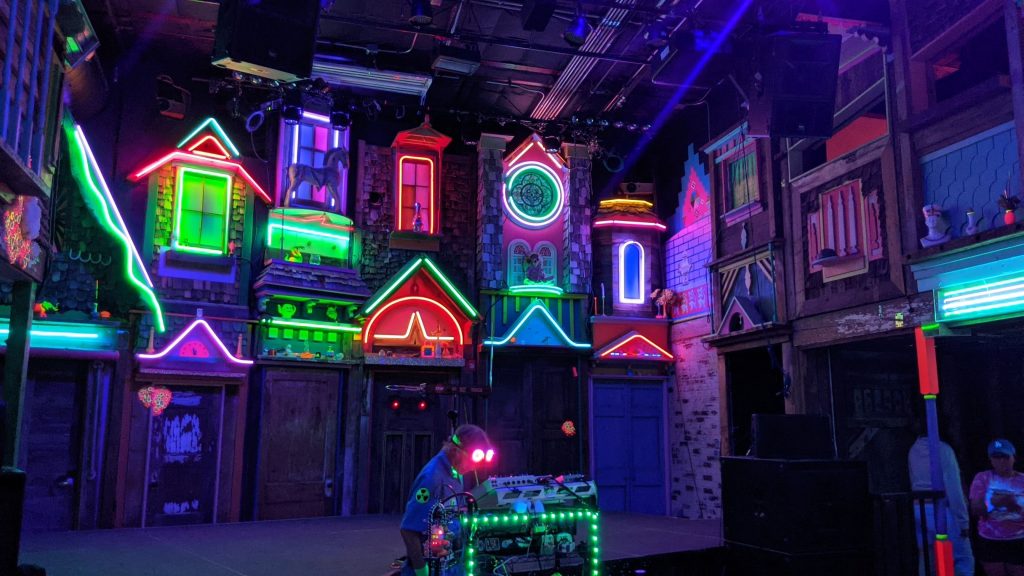
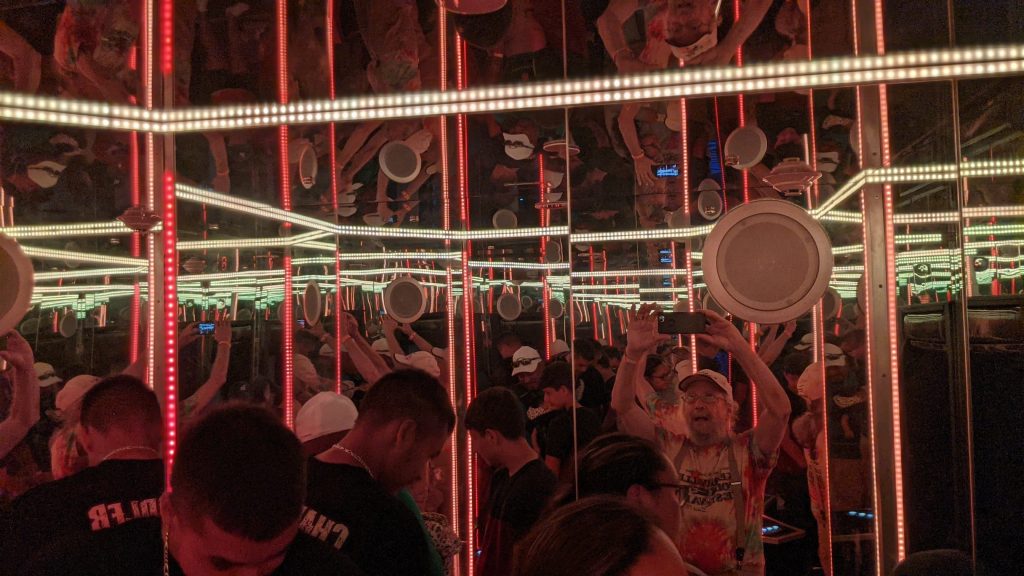
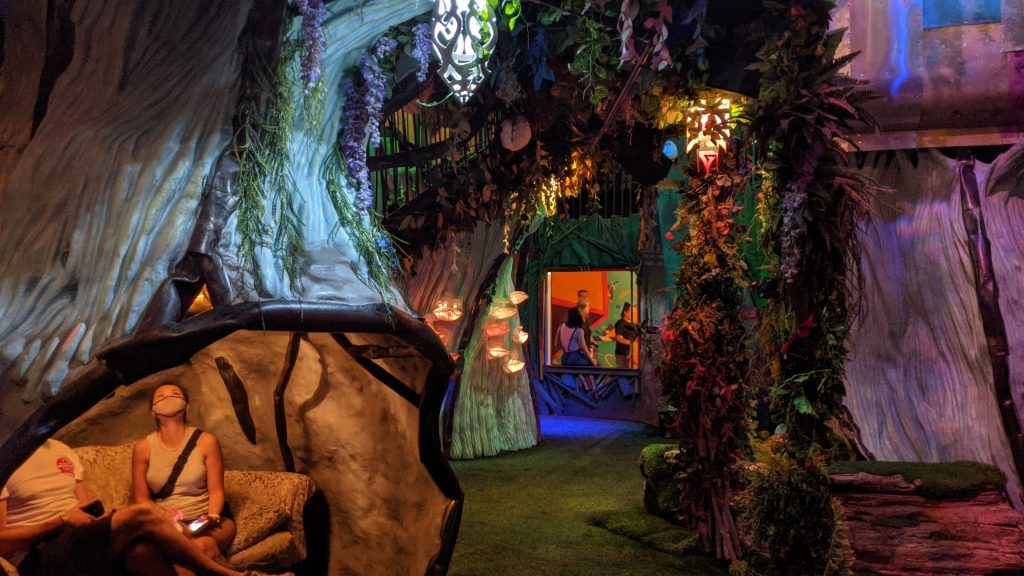
The fancy, well-regarded popular restaurant of choice was Maria’s, where we met my sister and brother-in-law, Carol and Salty (C&S), who just happened to be in New Mex at that time. The wait was 45 minutes. Once seated, we sat outside and engorged on pork, beer tequila, and sopapillas. On the way home, we were subject to a DWI check point and wondered about its legality.
C&S were lodging in a friend’s spacious one-bedroom casita not far from Lysa’s. They invited us to a driveway concert in a suburban cul-de-sac. The band played Americana. Neighbors greeted up and set up chairs in the street to listen. Coincidentally, also in attendance was Will Taylor, who knew some of these music folks. We toured the casita and met its owners, Caroline and Bob, former Houstonians. Endured the very same police roadblock on our way back.
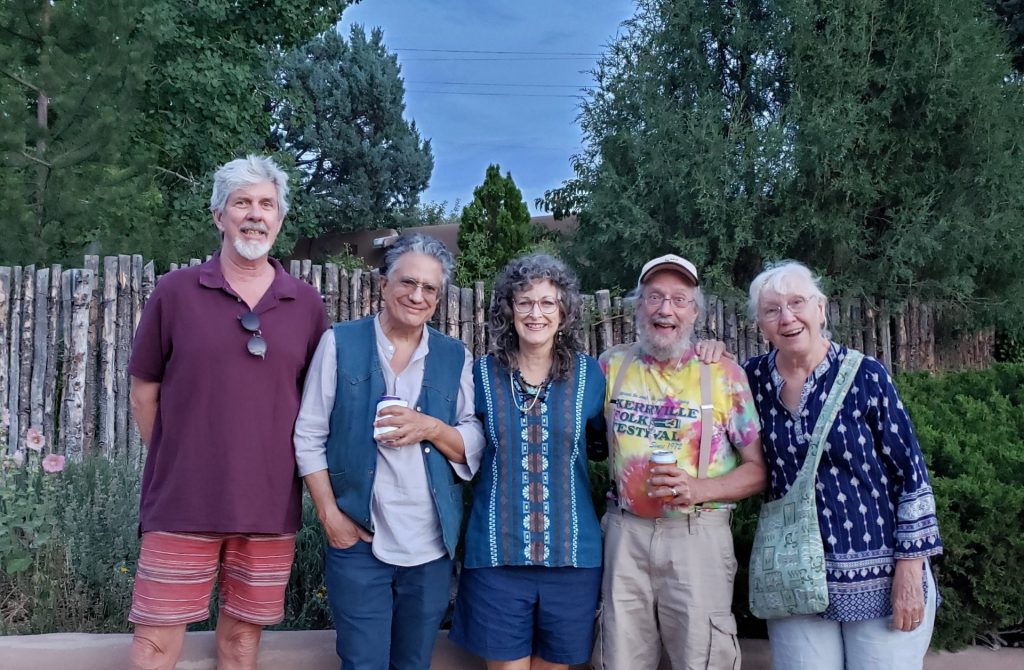
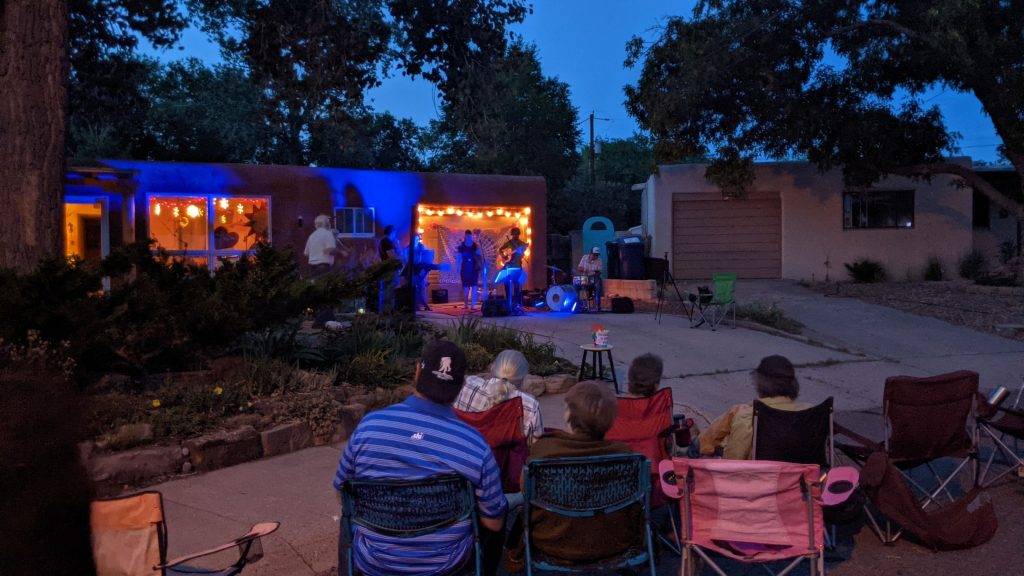
Sleep . . .
Monday, July 19
Arose to a sprinkly dawn. Broke our fast and packed. Thanks, dear Lysa, for being such an ebullient proprietor! So long, kitties.

Stopped at thrift store in a fruitless search for better hiking boots for Linda but procured three fine Hawaiian shirts for my collection. Filled the gas tank, stocked the cooler at Trader Joe’s on Cordova. North on US 84 got us out of the capital and soon parallel to the mighty Río Grande. Espied agriculture in the wetter areas, then evidence of river sports activities: white-water rafting, kayaking, outfitters. Winding up onto a tall mesa, we thrilled at the gorge’s deep slicing pathway. Mountains slowly got closer, looming to our northeast.
Pulled into Taos Valley RV Park, a former KOA just south of Taos, whose name roughly means “place of red willows,” where the Tao people live. Gary, a friendly fellow behind the front desk, checked us in and provided a map, restroom entry codes, and WiFi password. Diverse trailers, vans, and bus-sized rigs filled nearly each of the 92 slots. Speed limit: 5½ MPH. Trash containers are recessed into the ground. A couple acres of undeveloped ground comprise a pet walk with a nature trail. A coyote-proof fence surrounds the entire installation, beyond which lies a light industrial area and a few homes.
Situated toward the property’s back corner, tent sites are named for Native American groups. Ours was called Caddo and would be our base for three nights. Only one other tenter pitched nearby. A good-sized tree shaded a picnic table and pedestal grill. Fine gravel contained inside concrete curbing offered a comfortable, convenient spot for our cloth house. We were far enough from the main highway that only its dull roar reached our ears.


Thus settled, we ventured in to town. The main road, Paseo de Pueblo, was under construction and engendered confusion. Parked across from Guadalupe church and put coins in the meter. Seeking the plaza but unsure of its location, we wandered in the wrong direction. When we did find it, we learned that it was built this way deliberately for defensive purposes. On one or two historical occasions, the central space was barricaded against attack.
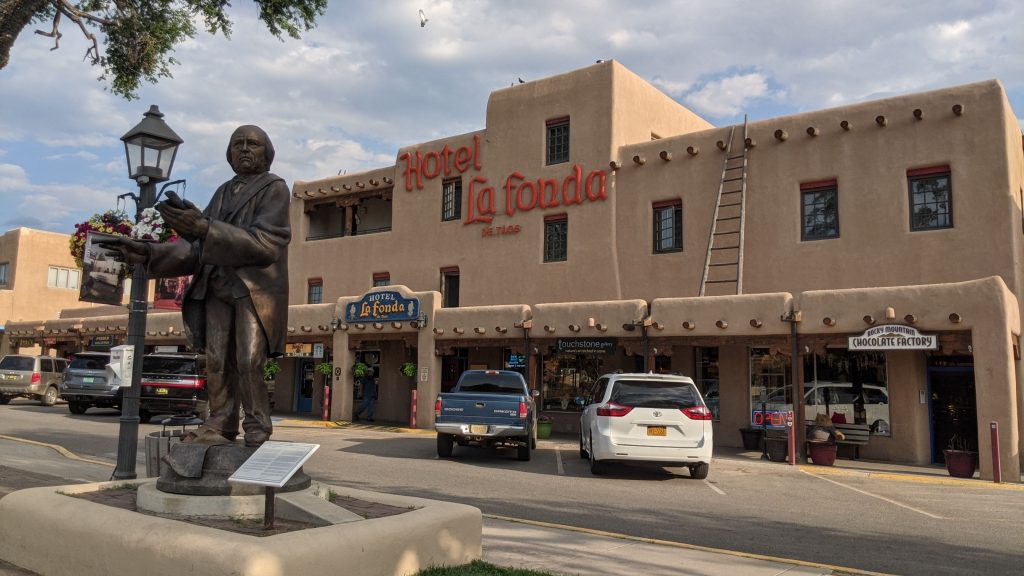
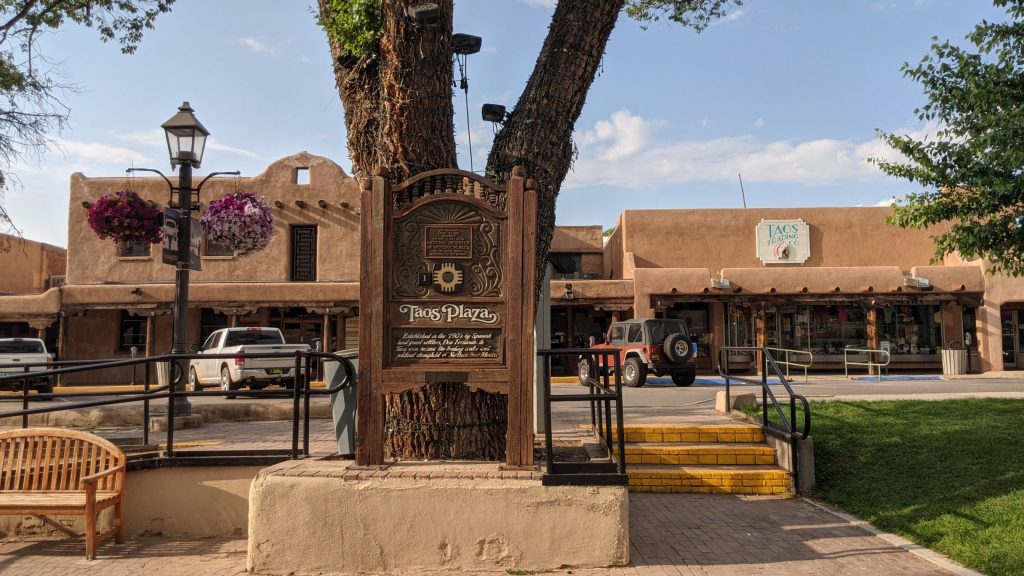
Since it was late on a weekday, only a few shops were open. A jewelry seller touted the Taos Trolley Tour, which would’ve been fun had our itinerary not been already planned—if at all. Next door, Hotel La Fonda de Taos collected $5 from each of us and let us look at D. H. Lawrence’s Forbidden Art collection. Renowned as a literary pioneer, Lawrence took special delight in putting brush to canvas. Not unlike some of his stories, these nine figures were considered obscene in his native England and had been impounded in 1929. Lawrence visited Taos in the early 1920s at the behest of his friend Mabel Dodge Sterne Luhan, who beckoned many art-minded types to the area. Creatives met frequently in the vintage hotel, and that’s where this collection is now housed. Though amateurish, the paintings represent a snapshot of Taos’s bohemian milieu.

This village assuredly possesses its own distinct personality.
Tuesday, July 20
Morning thermometer measured 55°. Pancakes made breakfast. Ravens kept us company. Readied ourselves to complete the Enchanted Circle driving tour through ye Sangre de Cristo range with a couple side trips.
First stop: iconic Rio Grande Gorge Bridge west. An ample rest area just across gave parking and easy access to hike over the gratefully arched structure—not for those who fear heights! Big River looks small from 600′ up. A widened walkway at the center allows for better viewing; a crisis hotline box is mounted there to prevent suicides. As we left, artsy-craft vendors were setting up inside the rest area.
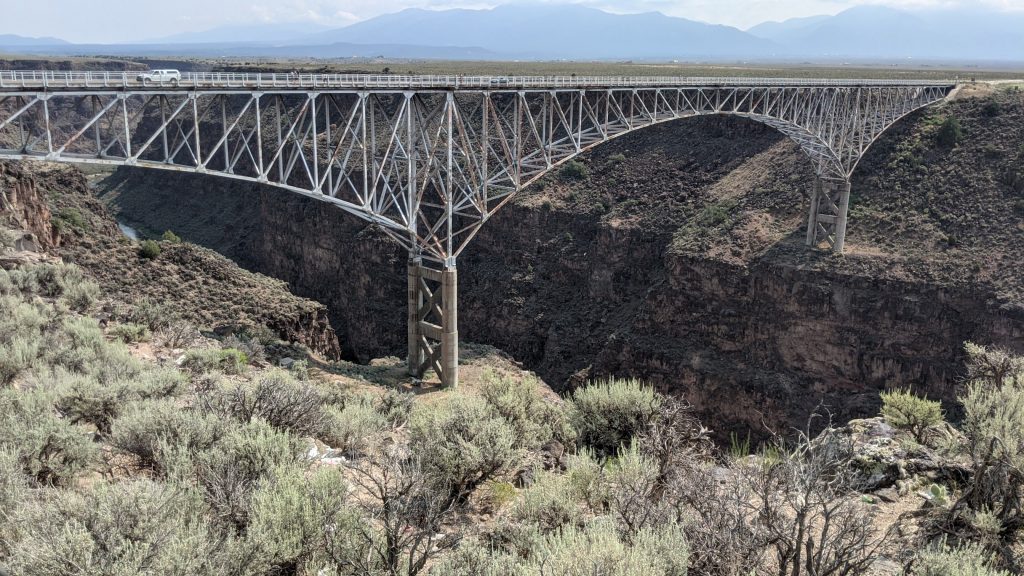
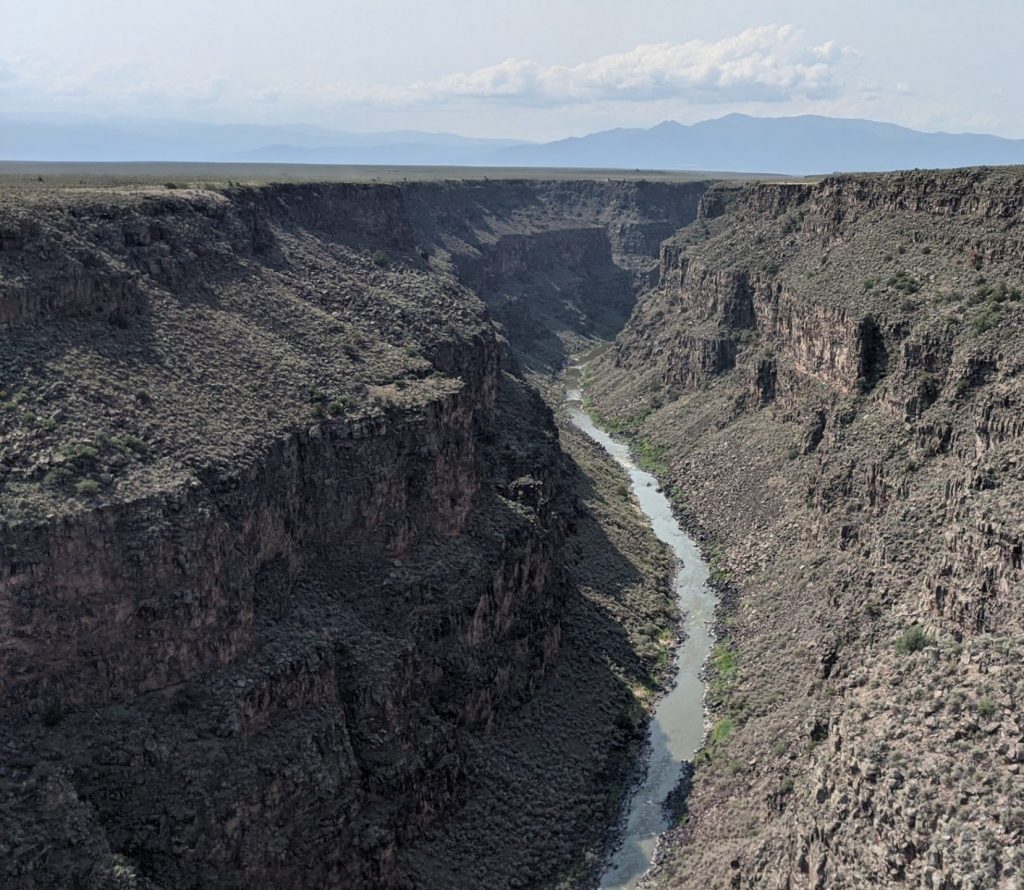
Charming Arroyo Seco is like a miniature Taos and straddles the road to the ski valley. Here we found an open-air performance stage, several shops such as AS Mercantile (antiques, gifts, and unusual finds), galleries, eateries, and the diminutive SnowMansion Adventure Lodge. In planning the trip, we had considered a stay in the latter, but decided on camping instead. Attached to an organic grocery, Sol Tribe Café peddled fruit smoothies (Strawberry Fields Forever), iced coffee, and amazing fresh croissants.
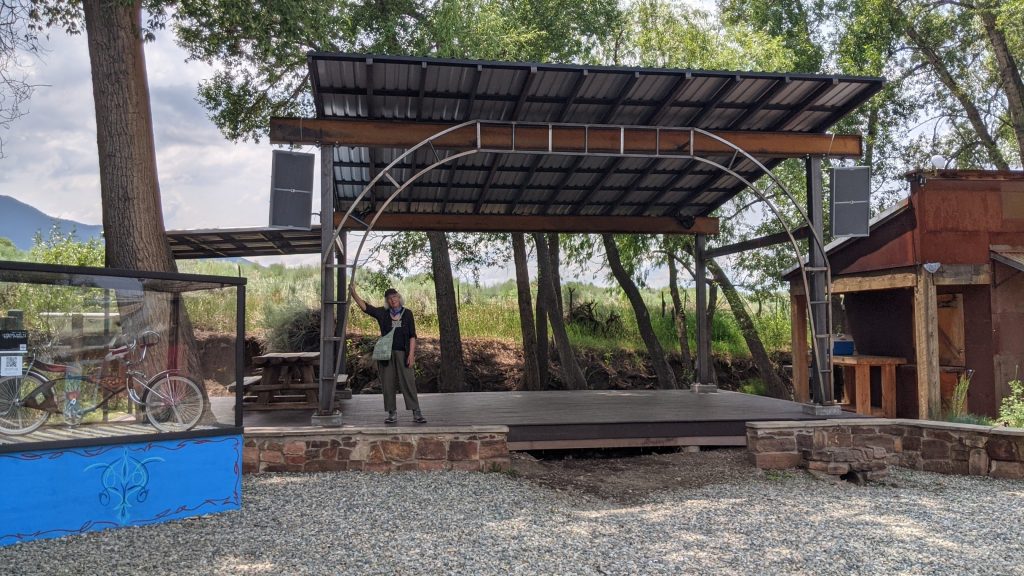
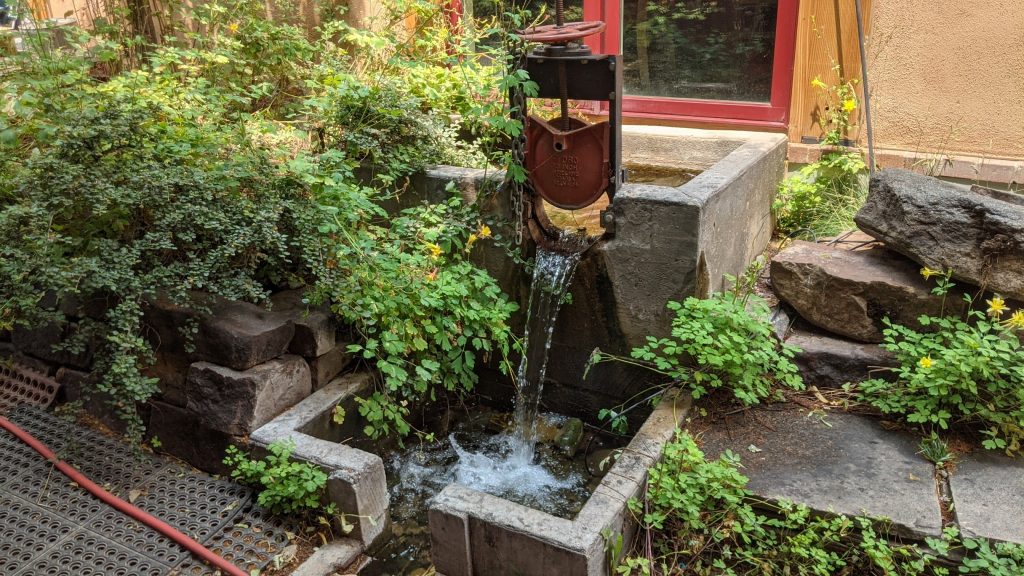
Took the narrow B143 past a pretty cemetery to Arroyo Hondo, which had a reputation in the late 60s for its hippie communes. The Lady of Sorrows Church was shut, so we photographed its exterior. Steered right onto NM 522.
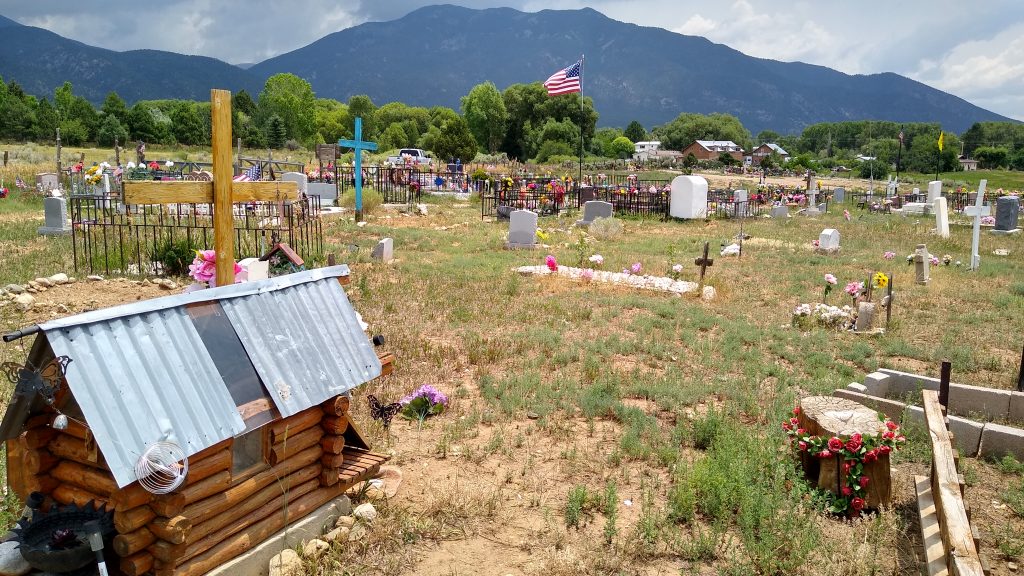

Cruised through Questa and bore east via NM 32. An enormous molybdenum strip mine intruded on our view to the north. The element is important in alloys like stainless steel, but scars such as this are the price we pay for access. Took note of the adjacent national-forest-run Columbine Campground and later realized I’d spent the night there with the family back in ‘89.
A rainstorm hit us fast and suddenly. It was just as suddenly over by the time we pulled into Red River. Not unlike Madrid, this former prospectors’ haven is strung along a main highway in a narrow valley. Its current reputation includes winter sports and fancy resorts. The stream itself rushed brown from runoff. We sauntered into the tourist office of the Conference Center and gleaned maps and brochures. Our old buddy Michael Martin Murphy runs a dinner theater he calls Rocking 3M Chuckwagon with brisket, biscuits, and ballads amidst tall pines. Alas, none of the famed folk or cowboy tunes were happening on that day at that hour, so we continued wheeling past Swiss-chalet-type log restaurants, accommodations, watering holes, and emporia with not an adobe in sight.
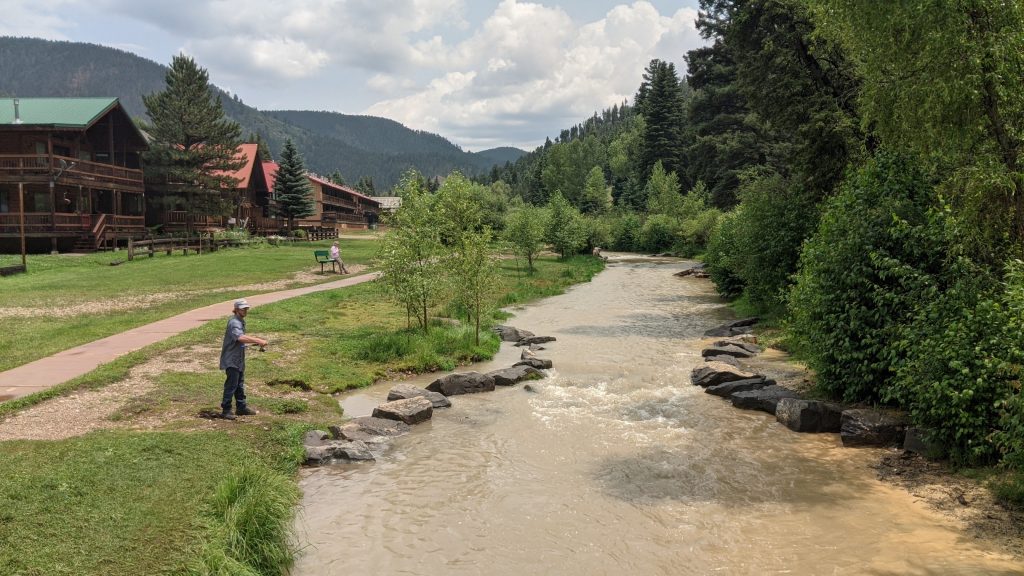
Another shower hailed our exit. That ended just as we mounted Bobcat Pass (elevation 9,820′) and crossed into the Moreno Creek watershed. Whereas the Sangre de Cristo’s western slopes exhibit the dryness of those desert surroundings, these east-side inclines are delightfully green. We roamed through Eagle Nest to US 64 past Angel Fire, then looped west again over a divide to the curvy canyon of Rio Fernando de Taos, which brought us full-circle back to town.
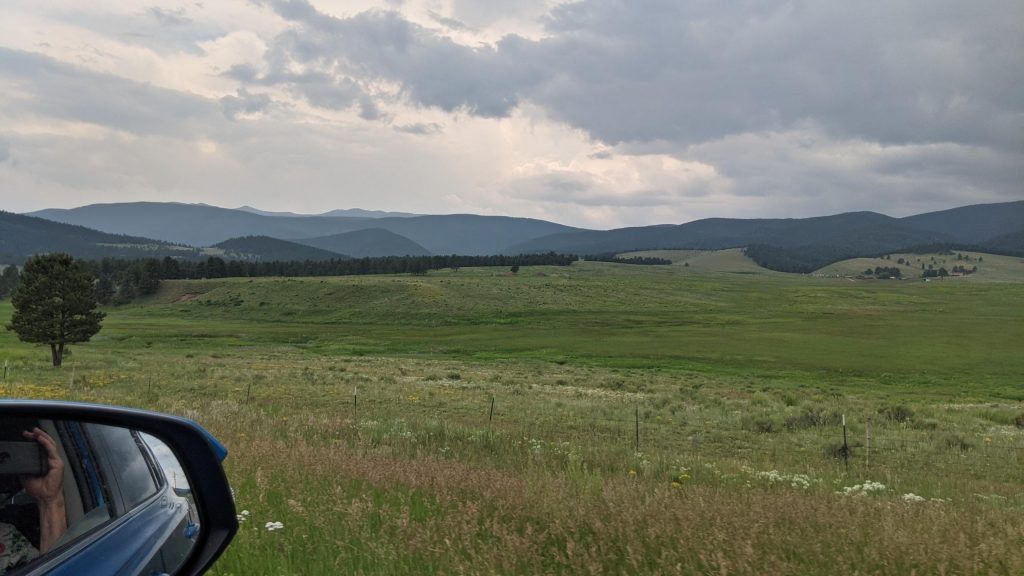
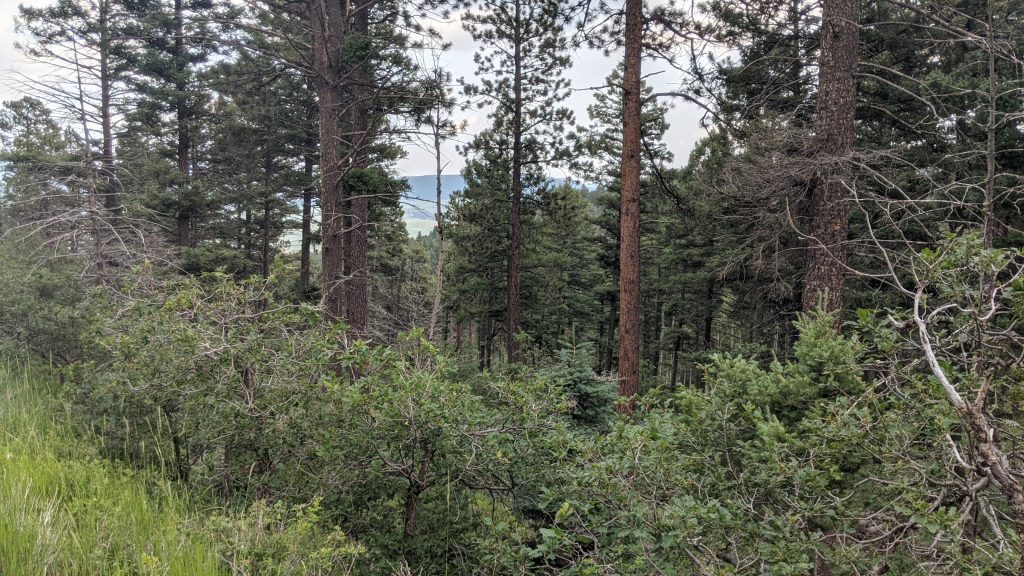
Browsed a clothing exchange that also sells camping and skiing equipment. Linda showed me how cross-country skis work and wants to take me on such a trek one cold day.
Made some modifications to our camp by elevating a soft tarp for more shade. L prepared salads just as a rain shower blew in. We ate in the vehicle and watched a youthful bicycle touring group scramble for shelter. Unfortunately, they didn’t spend the night or provide stories of their excursion. As the precip let up, we dried out sufficiently enough to relax under the lantern’s glow with drinks and views of a moonlit landscape before turning in.
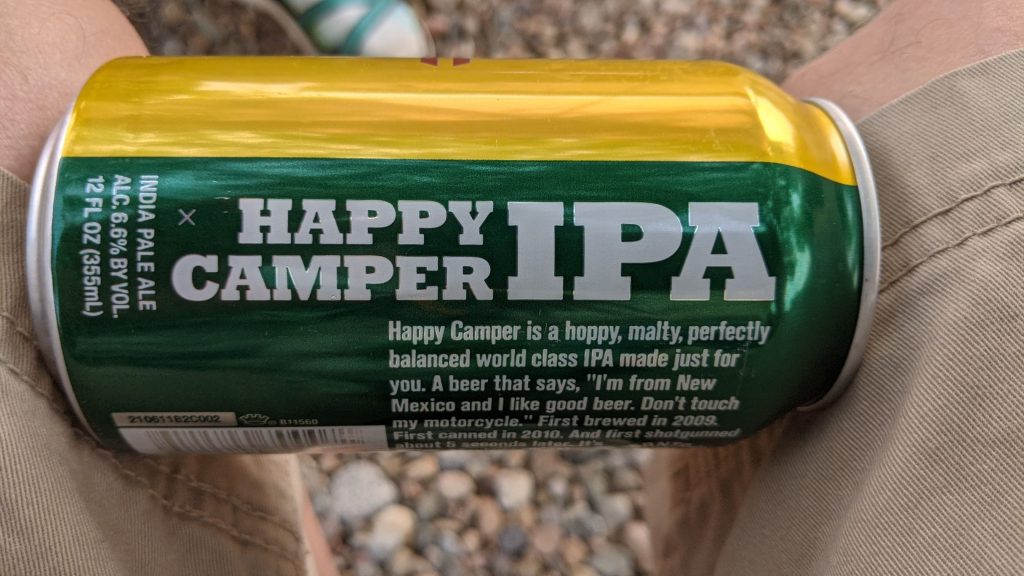
Wednesday, July 21
This was our all-in-town day. Found free municipal parking across Paseo del Pueblo Sur from the plaza, then located Manzanita Market. There waited a nomadic friend from Austin, Skye Love Hill, who spends some of the year in New Mex. We ordered refreshments. I chose Aztec hot chocolate with a nut scone, and we treated her to mushroom latté. Recharged our phones while catching up on our various travels. For a mere $20, Skye did us a tarot reading. Linda took notes on what the cards revealed: we’re community builders in transition—interesting and reaffirming.
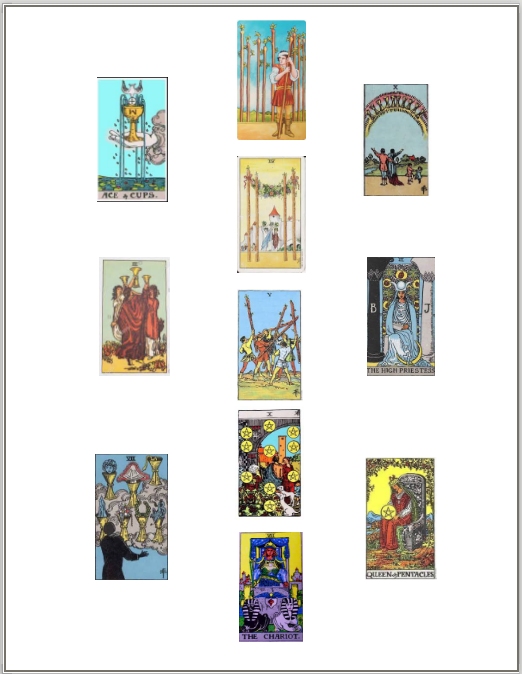
Strolled hither and yon around the plaza. Stepped into a darling toy shop that sported an indoor fairy-themed fish fountain. Browsed stores of all kinds along the north edge. Procured a turquoise and gold sun-symbol decal. Noted wood and rawhide drums (not cheap) and only guessed what the sad-eyed old native gentleman there was feeling. Crossed the Paseo to Kit Carson Road, where a Benedictine monk sold me two pocket saint charms: Juan Diego and Guadalupe.
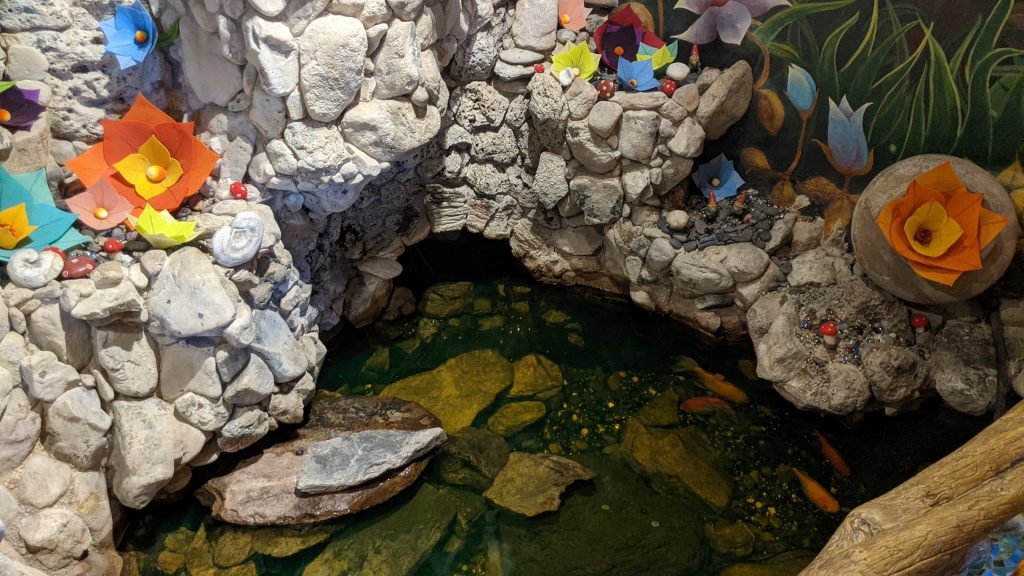

The street’s namesake’s museum beckoned. Built in 1825, the adobe was Christopher “Kit” Carson’s abode for a quarter-century from 1843 nearly until the frontiersman-soldier’s demise in 1868. We entered through the courtyard. Host Dave Cordova, also a disc jockey and local historian, told everything and ushered us into viewing a History Channel video about man and his times. An apprentice docent led us through the house’s other rooms and interpreted many artifacts. The kiva fireplace in the kitchen features two sides for diverse cooking. The Masons run this facility and remain dedicated to its rehabilitation.

We learned that, like David Crockett, Carson battled fictitious hero-narratives about himself in his own lifetime. Dave and I chatted up many curious connections with epic western musical narratives and performers MM Murphy, Michael Nesmith, and Bobby Bridger.
Clouds were gathering again. We snacked at the vehicle, then piloted it to the Taos Art Museum at Fechin House. Toured that, marveling at the paintings, wood carvings, and design. Its Russian owner, Nicolai Fechin, arrived in the village in 1927 at the behest of patroness Mabel Dodge Luhan. He regarded his domicile as “a Russian house evolved from the New Mexico mud.” What had been his studio (also of marvelous plan) is now the gift shop. Big windows in the ceiling provide cool, substantial light. I was reminded of Elizabet Ney’s Austin studio.

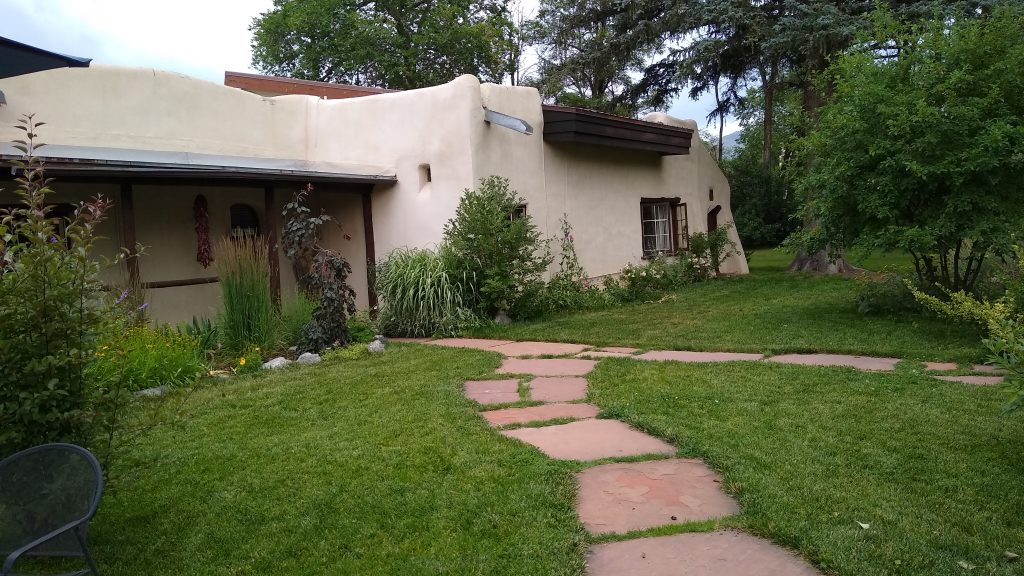
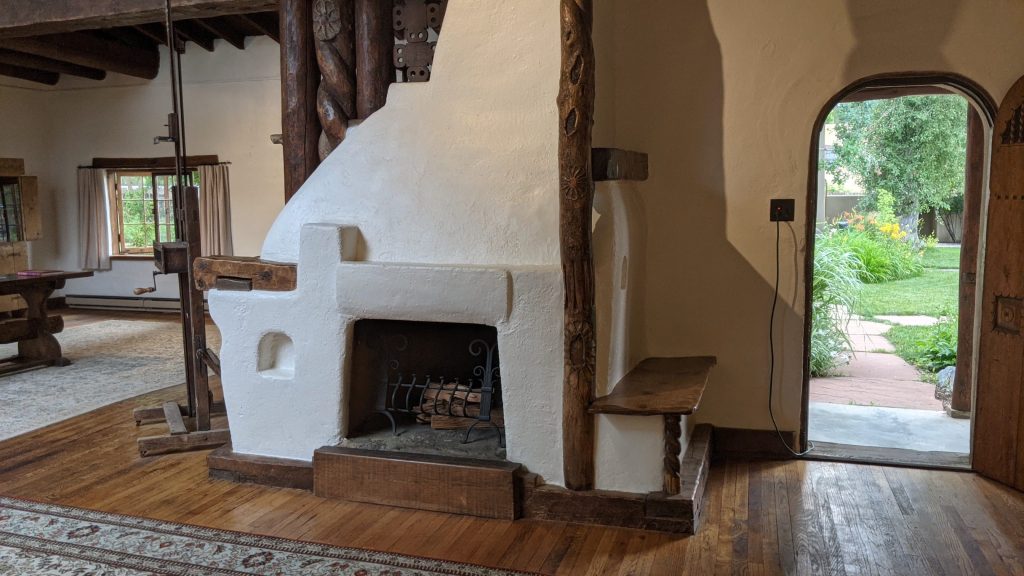
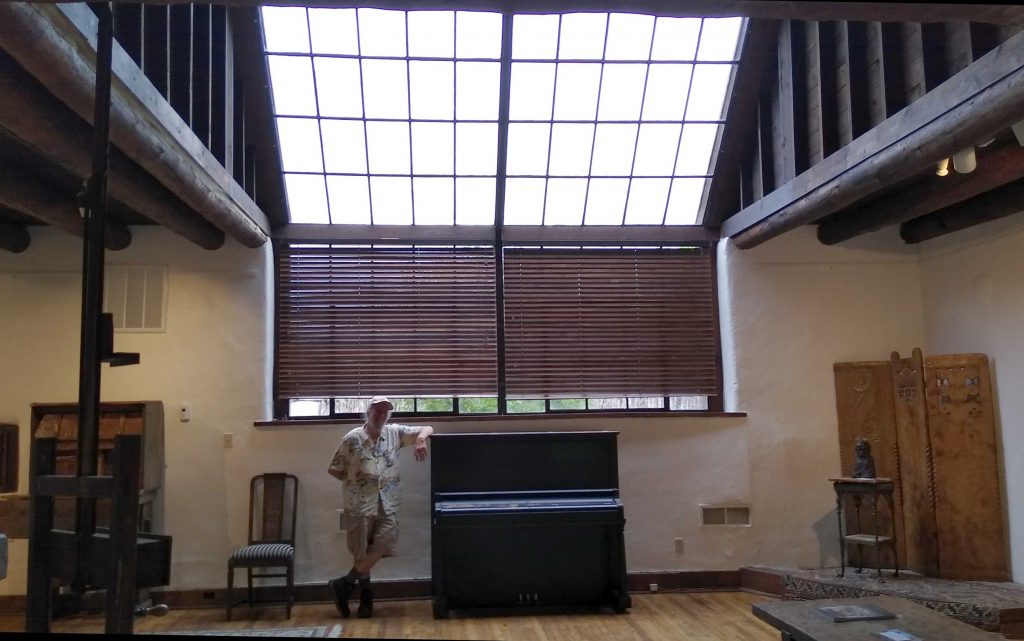
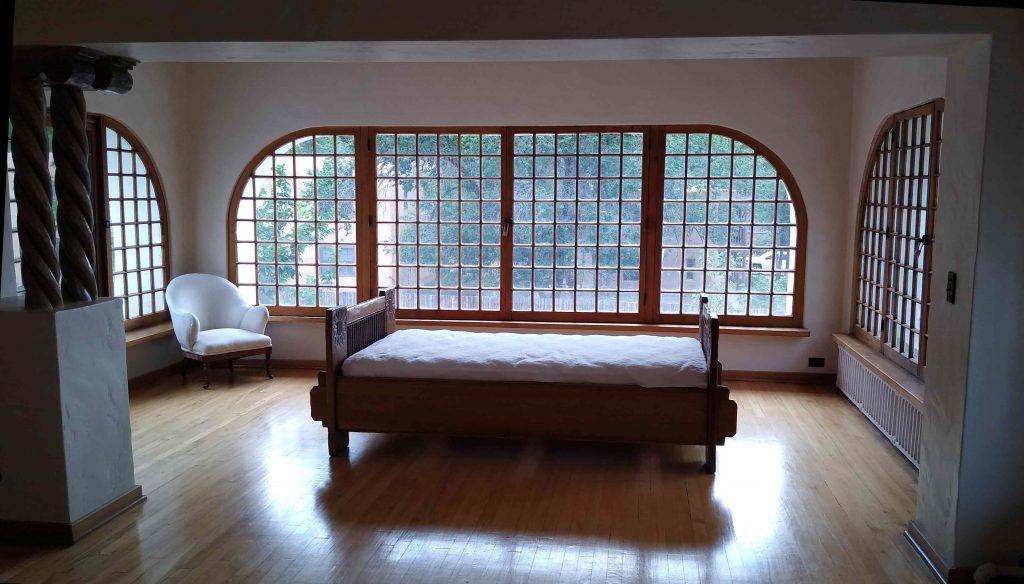
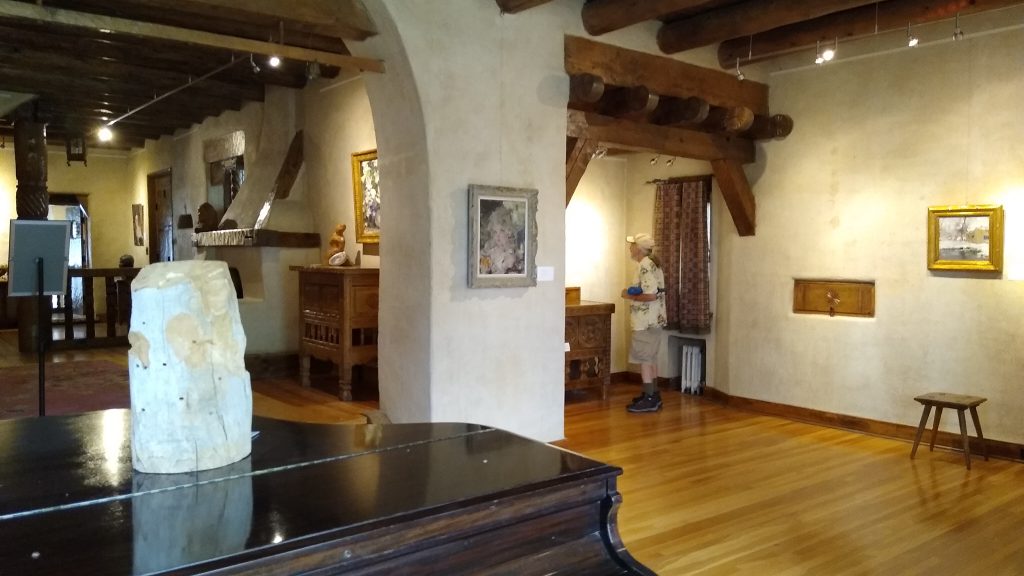
South next to nearby Ranchos de Taos and the presumed most photographed mission church in America, dedicated to St. Francis de Asís. Prominent are bulging buttresses in the walls and twin bell towers, all of adobe. That gift shop sold me a Guadalupe coin to accompany my pocket icon of the same spiritual being, who originated as Aztec Tonantzin (Our Dear Mother).

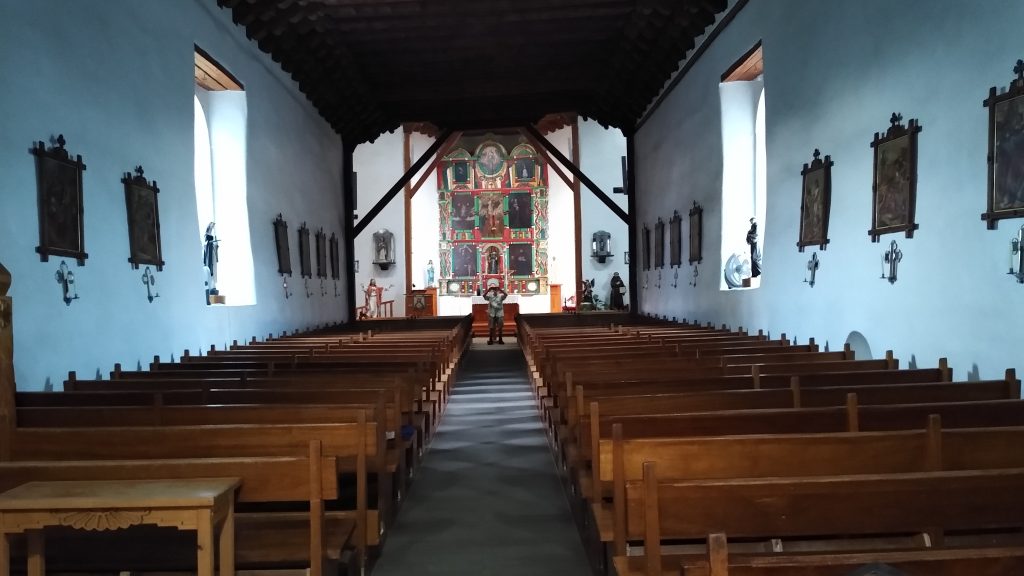
At another thrift store, Linda found fancy art paper and a book about a blue-eyed horse, Luna. Clouds passed us by, leaving only wind and a few sprinkles.
Last night in the RV park called for much merriment: pork, ramen noodles, beer, vodka.
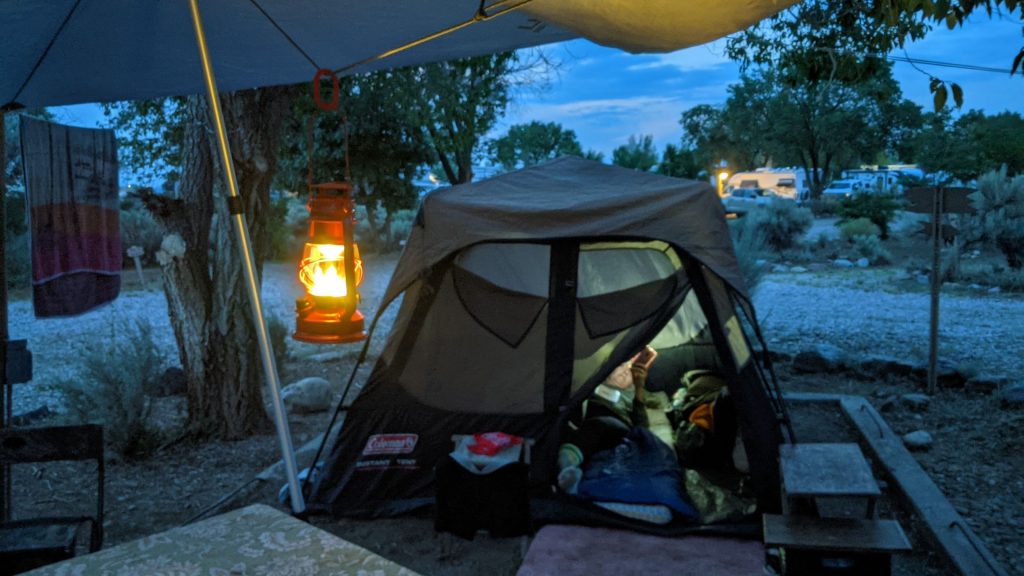
Thursday, July 22
A rooster crowed at the break of dawn. We made breakfast, struck camp, loaded Blue Rider, and departed with reluctance.
NM 512 drifts south, then east through the Sangre de Cristos along Rio Pueblo past dozens of scenic vistas. The only feeling greater than that these inspiring views generated was our determination to return. I imagined this drive in reverse, anticipating a time to come back. Noted palisades at Comales Campground.
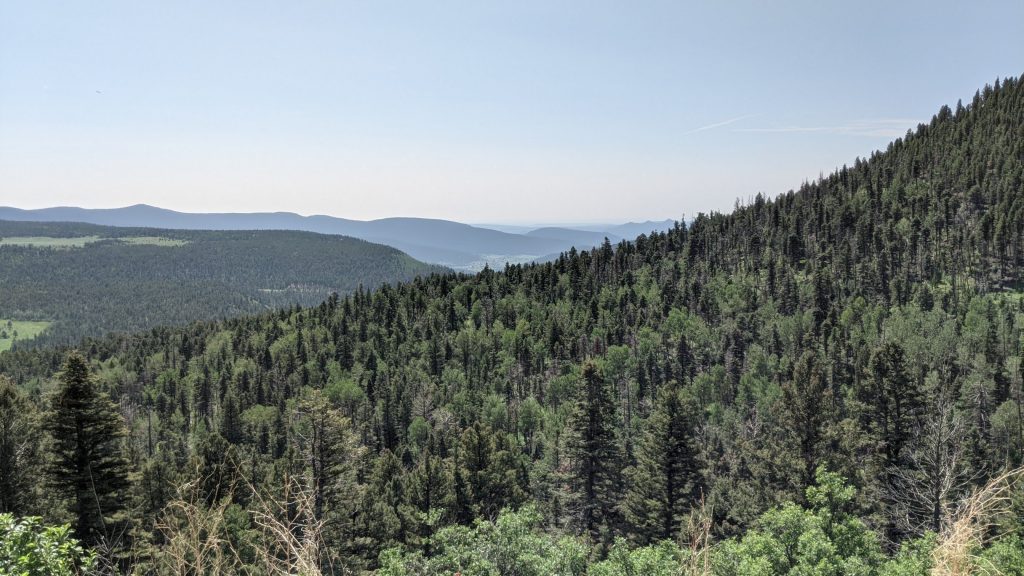
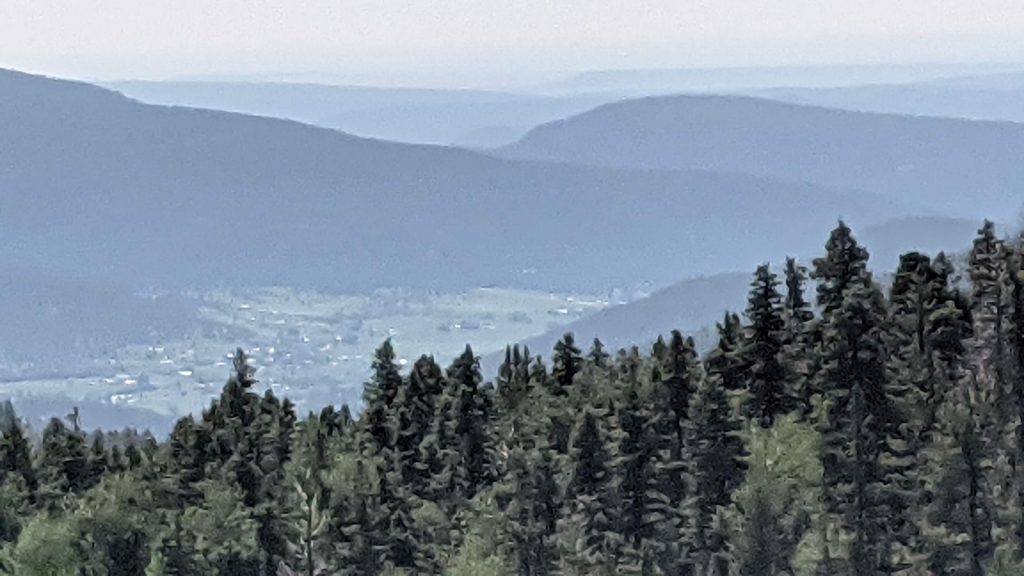
Somewhere near Holman Hill, we crossed a watershed boundary into the Mora (blackberry) River valley. That stream empties int o the Canadian River, flows through the Texas Panhandle, OK City to Sallisaw, and becomes part of the Arkansas River, a tributary of the mighty Mississippi. All things are connected.
At La Cueva, the mountains receded and a broad plain opened to our left. Skirted Las Vegas and found US 84, which would get us all the way to Texas. En route, we stopped in Fort Sumner and almost investigated the Billy the Kid Museum there. Instead, we kept on truckin’ to Bosque Redondo (round forest) Memorial, on the banks of the Pecos River.
Revisionist history is generally frowned upon by the conservatives among us, but new information always comes to light and must be integrated into the larger narrative. Thus, in a sense, all history is revisionist, just like every memory is a reconstruction. We were not prepared for what we found: this installation told of events here in the 1860s from a Native American perspective.
Designed by a Native American architect, the building looks like a hogan with a tepee growing out of it. A dark winding path led us to exhibit panels with quotes from and life-size photos of Navajos and Mescaleros who had been rounded up from their ancestral lands and force-marched 300 miles to an inhospitable and barren place. Stragglers, including pregnant women, were simply shot down. Disease, starvation, and exposure took its toll on some 1,500 unfortunates before this genocidal concentration camp was at last disbanded in 1868. Here was a vastly different opinion of the “hero” Kit Carson.

Drove through Clovis and thought of Norman Petty’s studios, where many early rock ‘n’ rollers laid down tracks. Changed our clocks across the Texas state line, and it was suddenly 6:20 p.m. Muleshoe offered the National Mule Memorial and its latest statue of Old Pete, who represents generations of this highly regarded, hardworking beast of burden. Soil turned red, and agriculture from center-pivot irrigation increased.
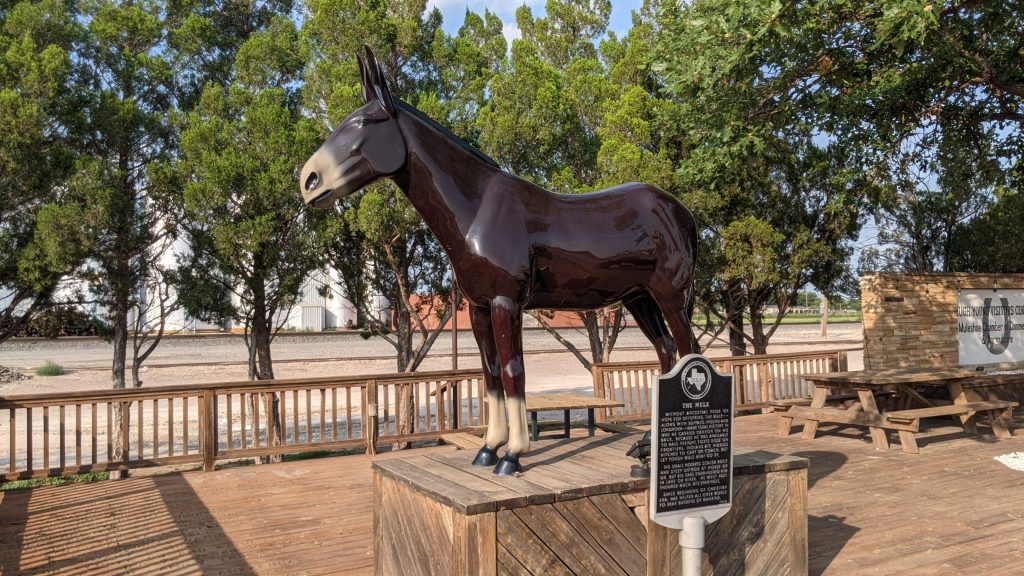
On to Lubbock, a.k.a. Hub City. Found the Journey KOA Campground after a couple wrong turns. Checked into our camping cabin, fulfilling a childhood bucket list item. These rustic gems come in at around100 square feet plus a front porch with a swing. Inside were a double bed, two single bunk beds, sitting bench, and corner writing desk. Air conditioning helped dampen any road noise. We placed our memory foam pad with its sheets atop the vinyl-covered mattress and found extreme comfort. A picnic table and faucet waited outside. Restrooms with showers, and store were but steps away. Linda took advantage of the indoor lap swimming pool. The situation made for a quick, convenient one-nighter: easy in, easy out.
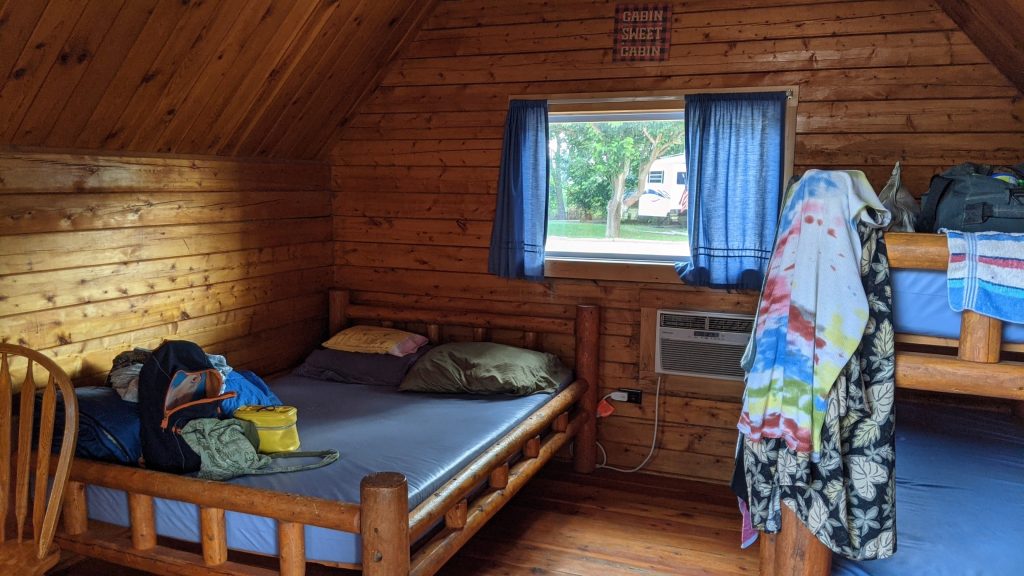


Friend Adam Pirtle suggested Flippers downtown for dinner. Pinball machines lined the walls and created tables. I think I ordered basic brats with bun and a lager. Back at camp, we slept.
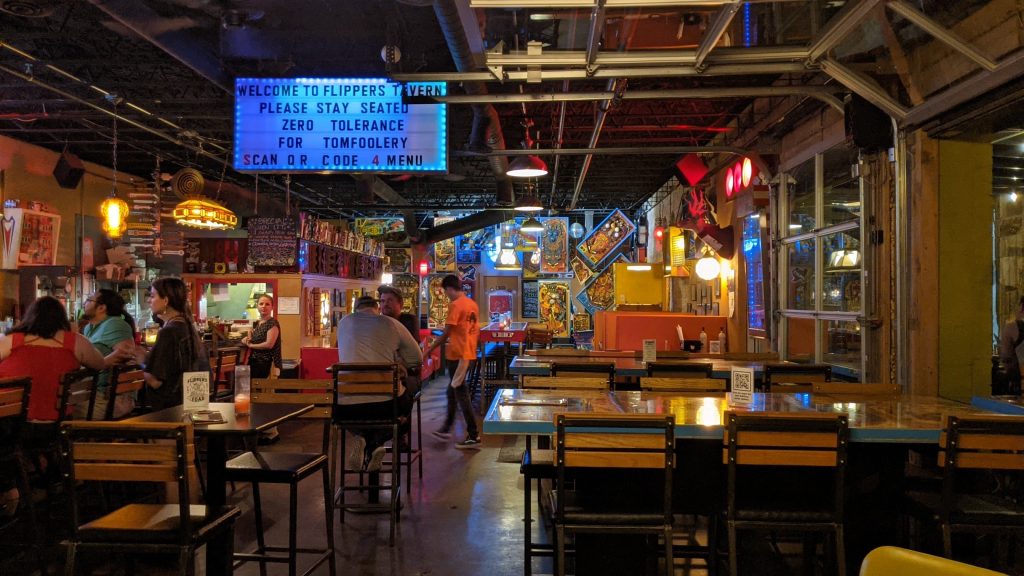
Friday, July 23
After bringing my travel log up to date, I scarfed a customary bowl of cereal and chased it with strong coffee. We strolled around the property and deemed it well-designed and neatly maintained. Rolled off.
Saw the campus of Texas Tech kinda by mistake, but were glad to behold.
No trip through Lubbock would be complete without a stop at the Buddy Holly Center. Saw a movie about his life, read names on the Wall of Fame, browsed exhibits, espied art in the attached train depot.
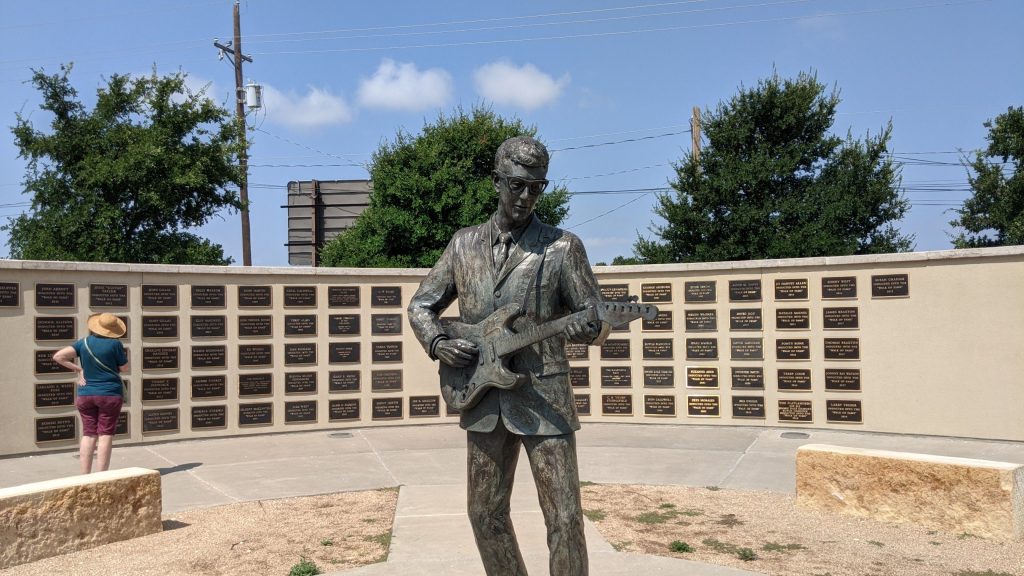
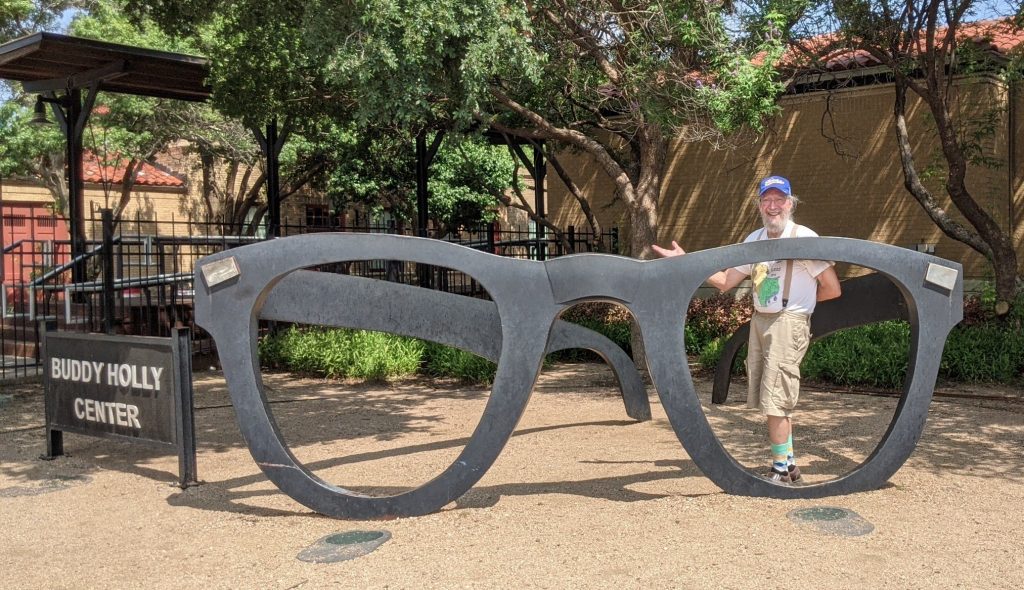
With a full tank, we departed Hub City at close to 1:00 p.m. Past Post, I pointed out to Lina the dramatic Caprock Escarpment, which separates the High Plains from the lower Rolling Plains. Lucked upon a superb roadside park by a little lake called Green Tank for a cicada-seranaded lunch. On and on. Advice: avoid the fried cheese in Lometa.
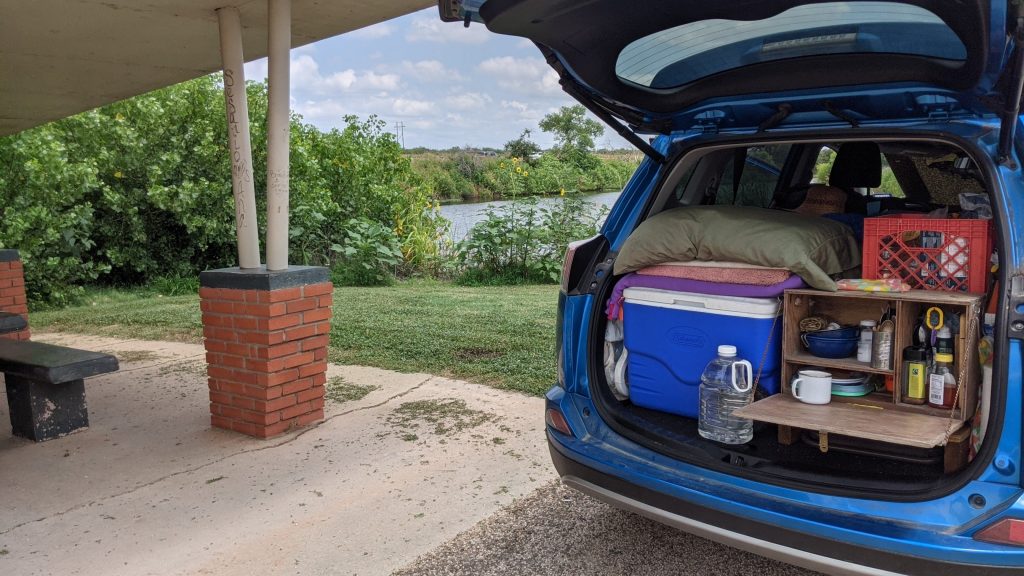
Foxie greeted us in a pique of excitement when we pulled into our Fig Cottage driveway at 8:20pm, back to where we once belonged.
Epilogue
Comments
Pingback: Southwest New Mex, 02-22 - Howie Richey Connects